
Tips, Tricks, and Doodads: Watch Out for Exposition! It's a Plot Killer!
I can't tell you how much I hate exposition. I know hate is a strong word. But it kills my plot. There I am plotting along. Happy as can be. I love plot. Plotting along is my favorite thing to do. Then here comes "necessary info." And in order to do my favorite thing I must engage with the thing I dislike the most.
The type of exposition I'm referring to is most commonly known as the "info dump." It's necessary information--often backstory--about characters that ultimately keeps the plot moving forward. So if you're reading about someone traveling to Tahlequah, Oklahoma for the Cherokee National Holiday, where they are about to reconnect with a long lost Cherokee sibling, you're going to need to know what first set them on this trajectory. The why and how is the plot. But nobody likes the what. It's all about the how. Everybody loves the how. How do I know this? Because how is the reason why I hate the what.
All kidding aside, I tend to minimize this type of exposition. Sometimes it involves introducing the characters in the novel. Readers must know all the major players. I tend to want to put this at the beginning of the novel so it doesn't disrupt my plot at critical moments later in the story line. I feel like it's early in the novel where readers have the most patience for this type of information. The "who's present" and why and how they effect the main character. It's like the main character is the sun, and the supporting cast are the planets in a solar system. Sometimes explaining gravitational pull is like pulling teeth. I know I'm mixing metaphors here but that's what exposition does to me. It makes me crazy.
Where was I? Oh yeah, I try to get away with as little exposition as possible. On a first draft, I info dump. I get it all out there. Then I start to whittle it away as I move through the revision phase. What's the smallest amount of exposition I can use without losing the "necessary info?" I want to start the reader in the middle of the action, and once I have the plot moving forward I don't want them to pause. Exposition makes them pause. So by reducing the amount of back story I can usually hide it with voice, using my personal colloquial method of capturing story on the page. If there's too much exposition, it's hard to hide it from the reader.
There are a number of other suggestions out there about handling exposition, like a character asking questions or spreading it out in small pieces, which are great and I use those from time to time as well. Mostly, I do what I mentioned above. I cut it down in size and flavor it with my writing voice. Typically, it works great but it can take many pass-throughs or revisions in order for it to feel like I've gotten it right. I'm a bit meticulous when it comes to this. Since it's such a hard disruption of plot, my perfectionism kicks in for the purpose of smoothing out the hard edges of exposition. I want to read through it as easily as I read through the rest of the novel.
If you have any suggestions, or methods that work best for your writing, I'd love to hear about it. How do you get through the "necessary info dump?"
Gritty Conversational: A Contemporary Native American Voice to Combat Erasure
So I was sitting in a classroom at the University of Oklahoma. This was about a decade ago. I was in my master's program and it was a special topics course on heteronormativity in American culture. We were discussing James Baldwin's work, and the professor said, "I love Baldwin's writing and I don't know how he does it." Then he looked at me. We locked eyes for a moment. I'm the only one in this MA program who has a BFA in Creative Writing. I immediately thought, I know how he does it. But before I had a chance to respond, he quickly stated, "And I don't want to know," as if he knew I was about to break the spell.
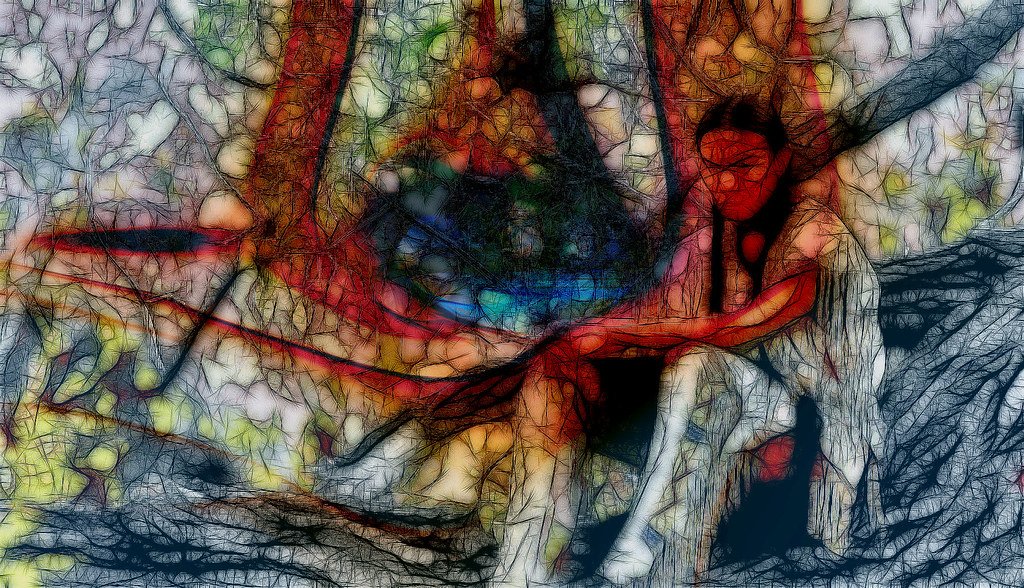
What we writers do can appear to have a magical quality. And after you've gone through a BFA or MFA program you learn all the craft techniques, like how to capture a plot, who to draw as a character, and, moreover, what voice to use to cast your spell.
This weekend I've thought a lot about my debut novel and varying elements within it, like structure, theme, character, and voice. I could talk for days on each of these, but often it's the latter that stumps most. Voice is elusive. While I thought about how the theme of my novel ties into the title, wanting to connect this for readers who might ask or for readers who might be interested in the larger thematics, but what I landed on was voice.
I thought about some of my favorite authors and how their writing styles are described. Words like conversational, gothic, magical, rural, and emotional kept popping up. Then I reflected on my own writing style or voice and came to each of the descriptors above. Often the writers we adore blend into the writer we become. And I landed most often on a single phrase: gritty conversational.

I'm a regionalist writer interested in capturing intertribal, multicultural, and transnational dynamics of my home communities--Tahlequah and Lawton, Oklahoma. As an engine for my writing, I'm most interested in realism. And the reason has to do with the romantical perspective people have about Natives. There seems to be this drive to reduce Natives to ahistorical tragic figures or overtly spiritual beings, like we're not contemporary people living and struggling inside a postmodern society.
Trying to convince people that we're human is a fulltime job in itself. Many of the depictions of Native peoples are of the above situations, and when both ahistorical tragedy and spirituality are mixed it becomes a much more harmful version of erasure. It's the modern version of the Pristine Myth, where people want to believe we Natives are no longer here, that Natives don't truly exist. We are either other worldly or in the past.
So I end up writing the grittiest version of who we are, because this captures Native people as being like everyone else. We work, care for our kids, do idiotic shit, love hard, fail even harder, and triumph in the last minute. But simply saying those words doesn't do enough. Readers need the emotional ride to truly understand, to truly grasp how we fit into the fabric of a global community.
This morning, I thought about my professor from back in the day, who wanted to be spellbound, and I couldn't help but think about how many readers want the Pristine Myth, they want Natives to be some sort of bizarre ahistorical tragedy comeback from the dead to save their souls. So weaving these stories with my "gritty conversational" style is a magic meant to wake readers from what they believe is a beautiful dream--but to us Natives it's the transformed but continued nightmare that began 530 years ago.
For Literary Eyes Only: Budding Archetypes for the Native American Literary Tradition
I'm open minded and enjoy talking to people about their Native ancestry. Folks get comfortable with me when they know I'm not going to judge them for admiring Native people, so they share their family lore. If they're writers, they'll likely mention a project they're working on where they have characters who are Native. Out of respect, they'll ask, "Can you make sure I'm not doing anything offensive?" and ask me to read their work. If I have time in my schedule, I'll gladly do so, but I've been busier than usual over the last year and haven't been able. This is part of the reason why I wanted to construct this list. This article is a serious examination of character archetypes for the purpose of creating literature. A unique approach situated from a Native lens.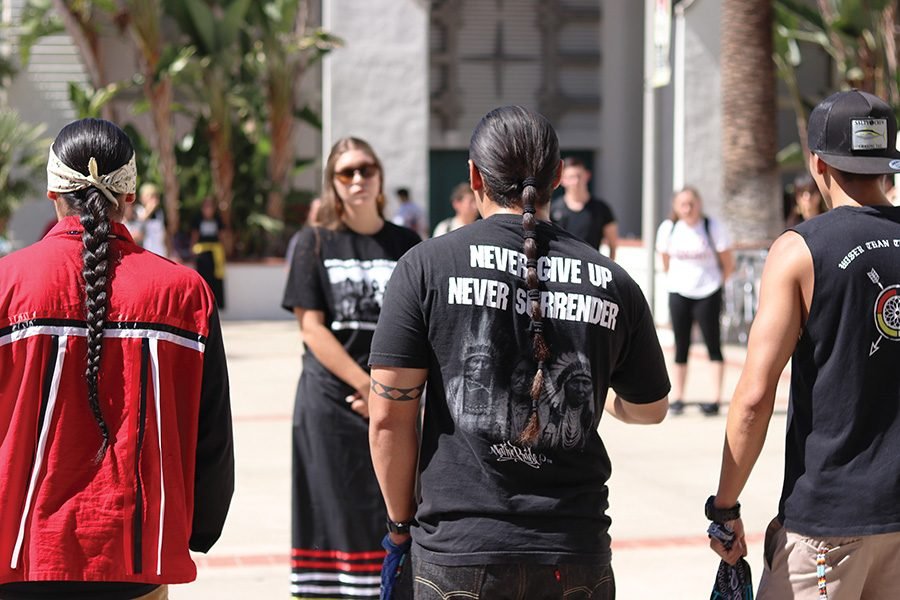 I like reading Native characters in books, and I'm often surprised when one comes up because usually it only happens in books that are specifically about Native people. So when I'm reading an adult fiction book outside that context I don't expect Native characters to arise. As you can tell by this article, I don't have qualms about non-Native writers writing Native characters. I draw the line at exploitation. Meaning, don't pretend to be Native and try to take awards, resources, and space from aspiring Native writers (stealing from the smallest minority in the U.S. is disturbing, and we have the highest disparity rates so it's harmful). The solution is simple: Write as an ally. Everyone wins.I say exercise your creative muscles and write a character who is Native. All writers take a risk when we "create" our characters, especially those who are not our own gender, race, class, or sexual orientation. Which is, more often than folks realize, every time we sit down to write. My line of thinking falls in line with Zadie Smith, who wrote a succinct and brilliant article about the subject, "Fascinated to Presume: In Defense of Fiction." I highly recommend you seek out her article in The New York Review of Books before you presumptuously make uneducated remarks in the comments section below.Another reason I'm motivated to create this list of archetypes has to do with Native literature itself (and I'm not going to get into the debate about "Native Lit" as a category or not--I think having our own category keeps the exploiters in check). The growing number of Native people writing literature has grown exponentially over the last decade. More and more of us are ready to step up and fill this "unmet demand" for Native American Literature. Readers are fascinated by our unique experience, and I feel they are seeking to "remake" their identity, or reconstruct it into one that's less destructive. I'd like to offer readers the opportunity to reflect on their identity by engaging with our own. And if I can do my part to make the world a less hostile place, then I've done something beneficial for not only my children but future generations, who are tasked with one choice: carry our trauma or carry our healing.
I like reading Native characters in books, and I'm often surprised when one comes up because usually it only happens in books that are specifically about Native people. So when I'm reading an adult fiction book outside that context I don't expect Native characters to arise. As you can tell by this article, I don't have qualms about non-Native writers writing Native characters. I draw the line at exploitation. Meaning, don't pretend to be Native and try to take awards, resources, and space from aspiring Native writers (stealing from the smallest minority in the U.S. is disturbing, and we have the highest disparity rates so it's harmful). The solution is simple: Write as an ally. Everyone wins.I say exercise your creative muscles and write a character who is Native. All writers take a risk when we "create" our characters, especially those who are not our own gender, race, class, or sexual orientation. Which is, more often than folks realize, every time we sit down to write. My line of thinking falls in line with Zadie Smith, who wrote a succinct and brilliant article about the subject, "Fascinated to Presume: In Defense of Fiction." I highly recommend you seek out her article in The New York Review of Books before you presumptuously make uneducated remarks in the comments section below.Another reason I'm motivated to create this list of archetypes has to do with Native literature itself (and I'm not going to get into the debate about "Native Lit" as a category or not--I think having our own category keeps the exploiters in check). The growing number of Native people writing literature has grown exponentially over the last decade. More and more of us are ready to step up and fill this "unmet demand" for Native American Literature. Readers are fascinated by our unique experience, and I feel they are seeking to "remake" their identity, or reconstruct it into one that's less destructive. I'd like to offer readers the opportunity to reflect on their identity by engaging with our own. And if I can do my part to make the world a less hostile place, then I've done something beneficial for not only my children but future generations, who are tasked with one choice: carry our trauma or carry our healing.
Mixed Blood In'din
I'm going to start with this one because I fall into this category and can speak to it quite effectively, lol. You'll see this archetype in just about every book written by a Native author. The most recent is Tommy Orange's novel, There There. I highly recommend picking up this book for a contemporary examination of mixed blood heritage in an urban American environment. It hits the mark in every way. But there are a number of writers who speak to a mixed heritage motif, such as Louise Erdrich, Brandon Hobson, and Susan Power. All of whom I would recommend.So what should we consider when writing a Native character of mixed heritage. From personal experience, being half Native and half Latinx, I've not had the self-hatred for being mixed, but that's a popular way of presenting this identity. It's true that mixed bloods often run into discrimination for "not being In'din enough," but I've run into the romanticization for being half Latinx more often than the discrimination. Often I'm seen as an anomaly and people are fascinated by the story of my Kiowa/Cherokee mother, who is from Oklahoma, United States, meeting my father, who immigrated from Chihuahua, Mexico. Typically, people want to know more.I'm only one of a very few Natives from my generation who are half Latinx. I'll say this, though. I live in Tahlequah, Oklahoma (in the heart of Cherokee Nation and work for Cherokee Nation) and there are many Mexican people who have married into Cherokee communities. I work with Indian Child Welfare and I can say undoubtedly that the next generation of Cherokees will have a high number of citizens who are part Mexican.As you'll read in many contemporary stories and many personal narratives online the mixed blood or half blood narrative is one wrought with postmodern dysphoria. Because of being constantly misidentified, people begin to look in the mirror and become dysphoric about what they see. This is where the self-loathing comes in. There seems to be an inability to "own" the diversity in ones lineage so this leads to confusion. The mix blood will suppress and even ignore the part of themselves that is White, Black, Mexican, etc. and instead attempt to only claim Native ancestry. As you can presume, this creates a host of issues, such as becoming over righteous or asserting themselves as an Indian "expert." In this modern era, your character might always try to be seen with full bloods or take pictures with full bloods to post on social media. There's a subconscious desire to be included as a "full blood" by association.
Super In'din
On the surface, this sounds like someone who might be a champion for Native communities. And I'm sure if you asked this guy he'd agree with you, lol. But the "Super In'din" is someone who weaponizes culture. This would be someone who considers himself an "expert" on his culture but he's not truly holding culture the way an elder might hold it. Meaning, he's not trying to pass on his knowledge and wisdom to the next generation. He's more interested in the power his knowledge holds. For character development, it might be better to view this person as a "gatekeeper" rather than an elder.In order to write this character, you're going to need some tribally specific knowledge for him to throw around. And I keep using the gender "he/him" because typically this is a male character--not to say the character couldn't be female, but typically this type of weaponized ego is a patriarchal trait. The most common behavior of a Super In'din is to shame people. So your character could criticize other characters for saying a word wrong or maybe wearing regalia in the wrong way. Your character will have a snobbish demeanor about him and think he's better than everyone. The only time you'll see him submit is when an elder walks into the room. Then he'll cower to the person who holds a more "respectable" way of carrying cultural knowledge.Ultimately, the Super In'din does more damage to his tribal community than he does good. It's better to see him as an extension of the colonizer. Meaning, he's oppressing his own people and doing the dirty work for the colonizer, like a pet. This is how a colonizer has reach into the center of a tribal community. The Super In'din is the colonizer's only way to penetrate the center. Otherwise, a tribal community would be able to heal internally if these individuals didn't exist. But where there is opportunity for power, people will play. So the Super In'din shames and humiliates his own people at every turn for self-fulfillment (hyper individualism).
Born Again In'din
The Born Again In'din could be confused with the Super In'din but there is a major distinction. The Born Again In'din wants to share her knowledge--not weaponize it. So this character will come into tribal culture at a time in their lives when they needed healing. Many recovering addicts become Born Again In'dins, especially if they start attending Native American Church (NAC) as a part of their recovery, which is common. But the Born Again In'din can also be an urban Native who comes to the reservation and gets swept away in learning tribal culture. In about a year, the urban Native will think they're more Native than the reservation Natives, if we're going to use cultural knowledge as a measuring stick.Your character will be overly excited to talk about cultural practices, like speaking the language. They'll start volunteering to say prayers at events. They want to show people how "In'din" they are. This is different than the Super In'din. It's better to see the Born Again as almost evangelical. They're not trying to convert people, but they hold tribal knowledge in such high esteem that they are certain it's going to help others.Here are two common everyday comparisons: If you had a friend who started martial arts and then became completely immersed to the point where all they talked about was martial arts, or if a friend started a new job that was interesting and new and they seemed to only talk about work. This is a similar pattern for the Born Again In'din.To capture this character effectively, you'll also need to have some cultural knowledge, but this person will know everything there is to know about medicinal plants in a specific region. So they'll say things like, "There's a cave outside Pumpkin Hallow where mushrooms grow just right," and they'll proceed to tell you at what phase of the moon when you should harvest said mushrooms. They know their medicinal roots and how to turn them into medicine. Also, they'll be in the process of learning the language. In fact, that's where they'll start. They'll be gungho about tribal language and use it as often as they can. This is where the Super In'din can shame the Born Again by constantly pointing out where their wrong, which can be often because they are in effect "students" of their own culture and are trying to gain more knowledge.The fruition of this character usually happens in one of two ways. They can become like the Super In'din themselves and start shaming other Natives. Or they can become a "savior" type and espouse wisdom to help the community.
Activist In'din
The Activist In'din has garnered some new attention with the rise of the #NODAPL movement, and now we have numerous protests around the world where protectors are standing up for ecosystems. But this archetype began in the 1970s with the rise of the American Indian Movement (AIM). In fact, AIM has maintained its presence since those early years and are the foundation for this current wave of activists. If not for AIM, then the current identity of "eco protectors" would not exist.Activist In'dins are our elite intellectual fighting force. It's better to see them as being more like a special forces unit, like Seal Team Six of the U.S. Navy. In fact, many of its members are veterans. If you're writing one of these characters, you're not going to see them very often. You might hear about them. But they are always serving as a protector at one of the many protests. They'll engage fully at one movement and when the protest is dismantled, then they'll move to another. In the flux, this character might show up in one of your stories, unless your story is about a specific protest. But when they show up, they'll be there for only a short time before they're off to the next eco protest.Behaviorally, your character will know the legal system. Activist In'dins have been arrested dozens if not hundreds of times, depending on their age, and can name their rights at the drop of a hat. Similarly, they'll introduce themselves as a Prisoner of War, saying, "My name is Oscar Hokeah, Gkoi'gkoo/Tsa'la'gi, slave/prisoner of Indian Territory/Oklahoma forcibly relocated by the Medicine Lodge Treaty of 1867 and the Treaty of New Echota of 1835." Not only are they historians but experts on specific treaties that affected their tribe.You can draw your characters as having a military type of personality. If you've had relatives in the military, then you can borrow from their demeanor. They tend to be very serious and ready to argue. Many of these individuals come from Law School and will spend a period of their young life at protests before they move on to budding careers as tribal lawyers. I'd describe these characters as being ready to serve. If you need something done, your Activist In'din character will be the first to volunteer to do it.
Hipster In'din
I saved the best for last. The Hipster In'din is the newest archetype and started showing itself about ten years ago. Image became god with the rise of social media, and these guys love themselves more than their mommas ever could. Lol, I'm teasing. Kinda. But the Hipster In'din is very concerned about trends and will jump onto the latest. If the trend is a Native protest against a pipeline, then they'll routinely post their personal opinions on social media. As soon as the trend changes to the protest of a mountain, so will their tweets. These guys are selling a product and that product is themselves. But this archetype is a global archetype so we all know someone like this. I'm just putting this into a Native context.Behaviorally, the latest trend is to be cynical so cynicism is the language of the Hipster In'din, but it's a special brand of cynicism. First you have to say something very sincere and when real human emotions surface you stuff them back down with a cynical comment, like, "Trump wants to start a race war, but at least I have my coffee," and then laugh. Your Hipster In'din character will need to be seen at trendy locations or trendy events. It'll all come through via social media. The major distinction will be the need to hold a certain "image." And the clothes will match the cynical language.The Hipster In'din character will carry themselves like they don't really care about anything or they are so disconnected that no one can hurt them. They are too cool to care. It can come off as arrogant, but it's an arrogance that's not fooling anyone. Other people in your story will be able to see it as a protective quality. The cynicism and arrogance is a way to hide from the pain of the world. Which will in turn make them appear to be even more fragile than if they were genuine.
Closing Thoughts
The above archetypes are found not only in contemporary Native American literature but also in modern Native society. They are the budding archetypes of our generation. My intention behind the list is to offer Native writers and non-Native writers character traits when developing their storylines. Discussions about literary archetypes, such as the hero, the villain, and the victim are common in literary classrooms, but we writers also consider the birth of new societal archetypes, such as the jock, the prom queen, and the nerd, which are then transferred into literary devices for writers. In the same vein, I offer the above archetypes as a nuanced approach to the literary tradition.
(Image borrowed from The Daily Aztec)
The 12 Year Journey of Unsettled Between
I spend a lot of time thinking about love, and what I'm about to discuss here is in the vein of love. But a love for cohesiveness, a love that desires modalities in cooperation rather than competition. Certainly, it took the very pessimistic concepts around Baudrillard's philosophy to engender my thoughts on this subject. But without Baudrillard I would've never reached this conclusive ending: competition is a mere copy of a copy. I hear you asking "So then what's the original source?" My answer: inspiration.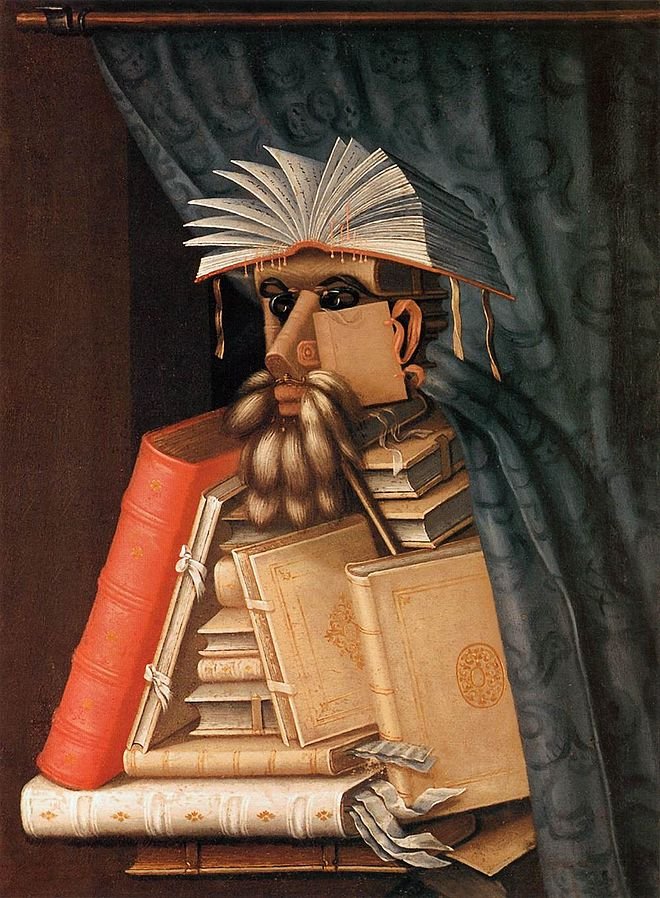 I've spent the last 14 months adding to and then revising a novel. It jumped from approximately 30,000 words to 73,000 words inside of a few short months. Then came all the revisions. I dove into each story and read and reread sentence after sentence, smoothing out the edges and slicing deeper details. Unsettled Between has changed dramatically and in the most beautiful ways. The thematic concept is much cleaner. The stories are further developed. The characters have richer personalities--all the characters--whether static or dynamic. And how was I able to alter a few stories into a full length novel? Inspiration.I'm going to be real honest here. Before I found representation for my novel, I had lost a great deal of inspiration. As many writers can in the ups and downs of life. I had written a couple of the stories in Unsettled Between from 2008 to 2010. They were published in journals ("Our Day" in American Short Fiction and "Time Like Masks" in South Dakota Review"). It was enough to give me a surge of inspiration. Success, even modest success, can give a writer enough fuel to burn for a full length novel.I sent one of the stories to Oxford American, which is a journal I dream of getting published with, and the editor turned it down but he wrote a little note in the corner saying something to effect of "Please submit more fiction in the future. I enjoyed your story," and this little note gave me additional inspiration to continue. So I completed a few more stories, and then a few more, and soon I had enough stories to call this a novel. But it was weak. It needed a lot of development.
I've spent the last 14 months adding to and then revising a novel. It jumped from approximately 30,000 words to 73,000 words inside of a few short months. Then came all the revisions. I dove into each story and read and reread sentence after sentence, smoothing out the edges and slicing deeper details. Unsettled Between has changed dramatically and in the most beautiful ways. The thematic concept is much cleaner. The stories are further developed. The characters have richer personalities--all the characters--whether static or dynamic. And how was I able to alter a few stories into a full length novel? Inspiration.I'm going to be real honest here. Before I found representation for my novel, I had lost a great deal of inspiration. As many writers can in the ups and downs of life. I had written a couple of the stories in Unsettled Between from 2008 to 2010. They were published in journals ("Our Day" in American Short Fiction and "Time Like Masks" in South Dakota Review"). It was enough to give me a surge of inspiration. Success, even modest success, can give a writer enough fuel to burn for a full length novel.I sent one of the stories to Oxford American, which is a journal I dream of getting published with, and the editor turned it down but he wrote a little note in the corner saying something to effect of "Please submit more fiction in the future. I enjoyed your story," and this little note gave me additional inspiration to continue. So I completed a few more stories, and then a few more, and soon I had enough stories to call this a novel. But it was weak. It needed a lot of development. 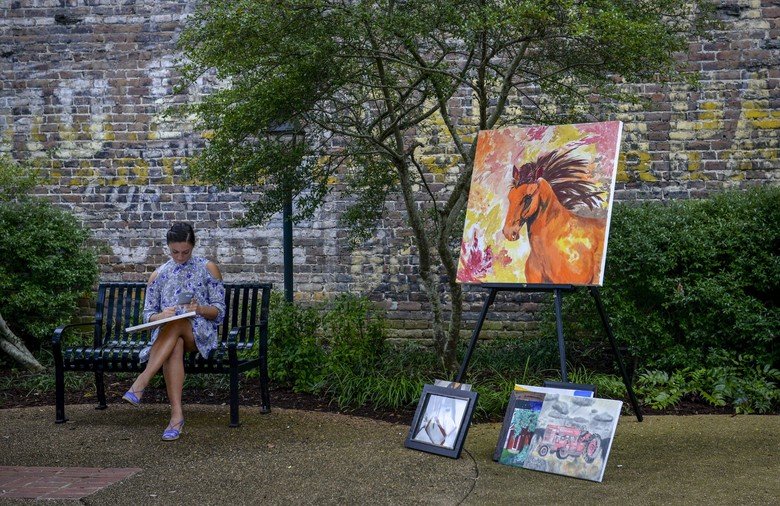 It was 2012 and I wanted some type of success. I needed inspiration. I knew if I could get someone to grab onto my book I'd have renewed energy. So I started sending out queries and got a request for a partial but the agent never even gave me a "No, thank you." The request came quickly in my querying process so I stopped sending out queries, which turned out to be a mistake. The agent never returned my email. And I emailed a few times asking for updates. But nothing. I was young in my career and took this as a defeat. In hindsight, I should've just kept querying. I hadn't submitted to very many agents. But I was naive and new to the game. I was defeated, or felt defeated, like maybe giving up was the only option. Soon I stopped carrying around my laptop and I forgot about the flash drives.A few years passed. I got divorced. Moved back to Oklahoma. Started raising my kids as a single parent. Life swept in like a tornado and carried me into a version of myself I didn't recognize.
It was 2012 and I wanted some type of success. I needed inspiration. I knew if I could get someone to grab onto my book I'd have renewed energy. So I started sending out queries and got a request for a partial but the agent never even gave me a "No, thank you." The request came quickly in my querying process so I stopped sending out queries, which turned out to be a mistake. The agent never returned my email. And I emailed a few times asking for updates. But nothing. I was young in my career and took this as a defeat. In hindsight, I should've just kept querying. I hadn't submitted to very many agents. But I was naive and new to the game. I was defeated, or felt defeated, like maybe giving up was the only option. Soon I stopped carrying around my laptop and I forgot about the flash drives.A few years passed. I got divorced. Moved back to Oklahoma. Started raising my kids as a single parent. Life swept in like a tornado and carried me into a version of myself I didn't recognize.
“When I sit down to write a book, I do not say to myself, ‘I am going to produce a work of art.’ I write it because there is some lie that I want to expose, some fact to which I want to draw attention, and my initial concern is to get a hearing.” — George Orwell
Then in 2015, I got this idea for a novel. Not the collection of stories I had written. Those stories I couldn't even look at. In fact, I couldn't even slide the flash drive with those stories into a USB. There was something psychological keeping me from going back. I told myself I needed to move forward. Keep thinking positive. So I wrote another novel, Uncle Called Him Spider. You can find posts on this blog where I work out kinks in the storyline. But this new idea was enough to get me believing I was a writer again. 60,000 words later. I had no doubt.So being in awe of my accomplishment. Writing 60,000 words is heavy lifting and it took me about six months to complete the first draft. Then I started the revisions and deepening the novel. After a year I had a solid "draft" of Uncle Called Him Spider. It was solid enough to call a draft and had interlaced subplots with protagonist and antagonist battling for top spot in a very esoteric field. It was different. I hadn't read a novel like it before so it left me feeling good about my hard work.
“There are no laws for the novel. There never have been, nor can there ever be.” — Doris Lessing
So late 2017 and early 2018, I start thinking about those stories. I'm like, "Maybe I should try to reread a few of them." Then a friend asked if I was working on any fiction. I told him about the new novel, but in the back of my mind I thought about those stories. His very considerate and thoughtful question was a springboard. Suddenly, I started thinking about the collection of stories again.I decided to try to slide a "certain" flash drive into a USB. And it worked. After reading the collection, I suddenly had a new vision for the book. So most of the stories were booted. They either didn't fit into this new concept or I felt like they just weren't good enough. So I wrote new stories. Then I polished them to a point where they were more than solid. They were ready to be published in journals. But my earlier defeat left me too frail to consider putting myself on the line. I couldn't handle the rejection, or the repeated rejection. Maybe one or two. But the dozens it can take to get a story published was going to be too much.
“If it sounds like writing, I rewrite it.” — Elmore Leonard
Then I heard of this event on Twitter. It was called #Dvpit (Diverse Voice Pitch) event. It was a simple but brilliant concept. You developed a twitter sized pitch of your novel. On the day of the event, you post the tweet. If an agent clicks on the heart icon, then you send them their requested material. I thought, this isn't nearly as brutal as the traditional querying process. I told myself, "It's a one time pitch," as opposed to the numerous I was visualizing. More importantly, it avoided the numerous rejections. Plus, it was new, different, and I got a little excited about it. So I marked it on my calendar and wrote a pitch. I polished over several weeks, reading and rereading until it was tight and succinct.I was surprised when multiple agents from large literary agencies started clicking on my tweet. What I liked most was how this pitching event gave me a sense that I was on the right track. It gave me inspiration. Long story short, I landed an agent. I couldn't believe my luck. The excitement carried over into the revision process. I was so beyond inspired that when my agent asked me to more than double the novel, I did so in a few short months. It almost felt easy. Likely because I was inspired by the success of working with an agent and speaking with someone who cared as much about my novel as I did.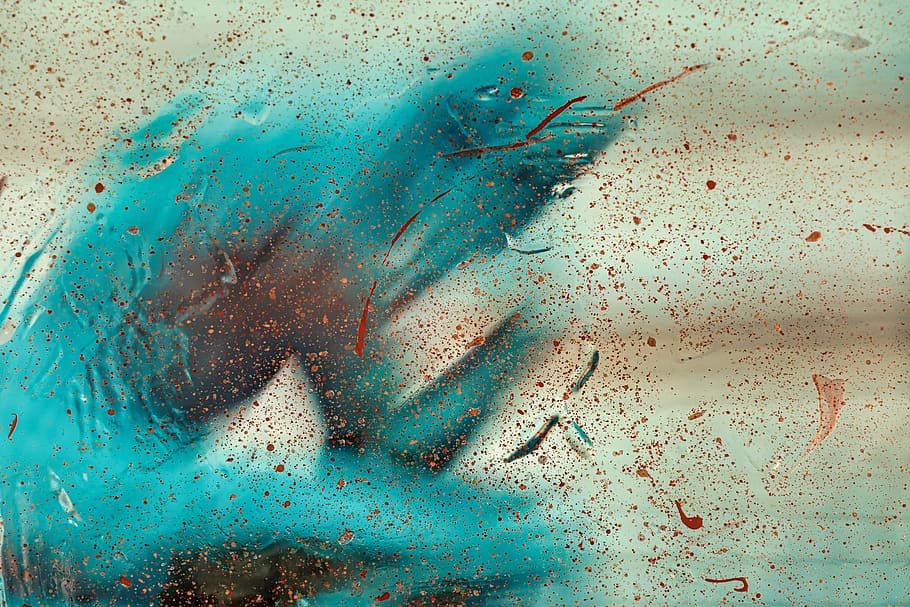 I can't tell you how lucky I am to be working with my agent, Allie Levick. I highly recommend querying her if you have a full manuscript to offer. As I reflect back on the last 14 months, she has asked me to look at specific pieces of the story in new ways. She's very hands on with the development and cares a lot about her work. I have high standards when it comes to professionalism. Allie carries herself as a true professional and I highly respect her opinion. A good agent will offer creative feedback, but one steeped in the rigors of her profession will inspire.So over the last few weeks, as I disappeared into revision work, I've thought a lot about things, like Baudrillard and love, cohesion and cooperation. I've seen people using "competition" to work themselves up. But I find inspiration to be the most impacting on art and life. In fact, from the competitiveness I've witnessed, I can see how inspired people energize themselves and the uninspired feed off the inspiration of others. Competition is only a fading copy of inspiration. Personally, I simply seek out inspiration or wait for it and trust it'll find its way toward me. Then once my spirit has risen with its power, I hold onto it as long as I can.
I can't tell you how lucky I am to be working with my agent, Allie Levick. I highly recommend querying her if you have a full manuscript to offer. As I reflect back on the last 14 months, she has asked me to look at specific pieces of the story in new ways. She's very hands on with the development and cares a lot about her work. I have high standards when it comes to professionalism. Allie carries herself as a true professional and I highly respect her opinion. A good agent will offer creative feedback, but one steeped in the rigors of her profession will inspire.So over the last few weeks, as I disappeared into revision work, I've thought a lot about things, like Baudrillard and love, cohesion and cooperation. I've seen people using "competition" to work themselves up. But I find inspiration to be the most impacting on art and life. In fact, from the competitiveness I've witnessed, I can see how inspired people energize themselves and the uninspired feed off the inspiration of others. Competition is only a fading copy of inspiration. Personally, I simply seek out inspiration or wait for it and trust it'll find its way toward me. Then once my spirit has risen with its power, I hold onto it as long as I can.
Support a Native owned Etsy shop, Allies United, where I offer unique merch for allies of social justice movements, like MMIW, Native Lives Matter and Black Lives Matter. Take a look inside my Etsy shop here: etsy.com/shop/AlliesUnited.
(Images were borrowed from wikipedia, columbus,af.mil, and pxfuel)
The Crocodile, the Goat, and the Unicorn: Unique Approaches to Character Development by Unifying Karpman's Drama Triangle, Evolutionary Astrology, and Stanislavski's Method Acting
There I am, like you, and so many writers, sitting at my computer and starting a new writing project. I'm drawing up characters because this story has been running through mind for years and it's finally ready to go onto a page. Since I already have a working idea of who my main character is and her antagonist, I now need to weigh her against Karpman's drama triangle. What is her good, bad, and ugly? This is how I've drawn multidimensional characters for over 10 years. But then two other creative forms changed my approach: Evolutionary astrology and Stanislavski's method acting.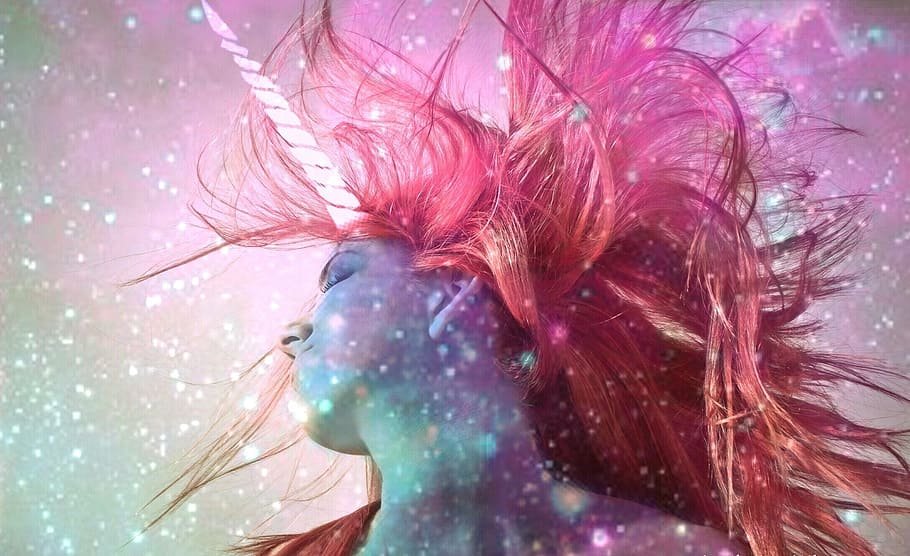 Those of you who have been following my blog for some time know that I'm a capricorn and if you follow my Twitter as well you'll see posts from time to time about being capricorn. I've followed astrology closely for about two years. I'm writing a character for another novel, or another novel that's rolling around in my mind right now, and astrology started as research for that character. Then I started to become more and more intrigued by it.So I'm a capricorn rising, capricorn sun, and libra moon in Western astrology, which is also called evolutionary astrology, and commonly practiced in North America and Europe. In Vedic astrology, which is the most commonly used form in Asia, I'm a capricorn rising, sagittarius sun, and virgo moon, with my moon nakshatra in uttra phalguni. If you follow astrology closely, you'll know what each of those mean, but if you don't it's how the stars were aligned the moment I was born and determines my personality, my ambitions, and my obstacles.So in both forms of astrology, I'm a capricorn, which isn't always the case because each measures birth timeframes differently. I'll not go into those details. But being a capricorn has always resonated with me.
Those of you who have been following my blog for some time know that I'm a capricorn and if you follow my Twitter as well you'll see posts from time to time about being capricorn. I've followed astrology closely for about two years. I'm writing a character for another novel, or another novel that's rolling around in my mind right now, and astrology started as research for that character. Then I started to become more and more intrigued by it.So I'm a capricorn rising, capricorn sun, and libra moon in Western astrology, which is also called evolutionary astrology, and commonly practiced in North America and Europe. In Vedic astrology, which is the most commonly used form in Asia, I'm a capricorn rising, sagittarius sun, and virgo moon, with my moon nakshatra in uttra phalguni. If you follow astrology closely, you'll know what each of those mean, but if you don't it's how the stars were aligned the moment I was born and determines my personality, my ambitions, and my obstacles.So in both forms of astrology, I'm a capricorn, which isn't always the case because each measures birth timeframes differently. I'll not go into those details. But being a capricorn has always resonated with me.
"In the end, you will find yourself with a long list of accomplishments and overcomes challenges that will mark your name, and these things you have done should bring you joy in the later years of your life because you decided that you would never quit." -- Bellatuscana
 For most of the last two years, I had been only aware of the capricorn sign symbolized by a climbing mountain goat. Then as I went deeper into researching astrology I discovered ancient astrology also symbolized the sign with a crocodile and a unicorn. So the cycle goes like this: the sign starts as a crocodile moves into a goat and then ends as a unicorn. So in it's lowest form, capricorns had strong crocodilian traits and were once viewed singularly as this reptile. Then at some point in human history, capricorn people evolved and started to act more like the mountain goat or a mythological sea goat. This is how the sign is currently symbolized. And so in the future, capricorn people, in their highest form of evolution, will start to take on traits of a mythological unicorn. The two horns of the goat fuse and turn into one, which symbolizes the spiritual use of the third eye.So how does all this pertain to Karpman's drama triangle and Stanislavski's method acting?Stephen Karpman developed a victim, rescuer, and persecutor psychotherapy model in 1961 for transactional analysis. In story writing terms, we writers modified this into a model for creating complex characters and applied the terms of victim, hero, and villain. So each character, aside from static characters, should have personality traits showing each of the three. This will reflect on the page as a real person to the reader, because, as Karpman pointed out in his model, people revolve between victim, rescuer, and persecutor in social situations. So if real folks do this, then so should your characters.
For most of the last two years, I had been only aware of the capricorn sign symbolized by a climbing mountain goat. Then as I went deeper into researching astrology I discovered ancient astrology also symbolized the sign with a crocodile and a unicorn. So the cycle goes like this: the sign starts as a crocodile moves into a goat and then ends as a unicorn. So in it's lowest form, capricorns had strong crocodilian traits and were once viewed singularly as this reptile. Then at some point in human history, capricorn people evolved and started to act more like the mountain goat or a mythological sea goat. This is how the sign is currently symbolized. And so in the future, capricorn people, in their highest form of evolution, will start to take on traits of a mythological unicorn. The two horns of the goat fuse and turn into one, which symbolizes the spiritual use of the third eye.So how does all this pertain to Karpman's drama triangle and Stanislavski's method acting?Stephen Karpman developed a victim, rescuer, and persecutor psychotherapy model in 1961 for transactional analysis. In story writing terms, we writers modified this into a model for creating complex characters and applied the terms of victim, hero, and villain. So each character, aside from static characters, should have personality traits showing each of the three. This will reflect on the page as a real person to the reader, because, as Karpman pointed out in his model, people revolve between victim, rescuer, and persecutor in social situations. So if real folks do this, then so should your characters.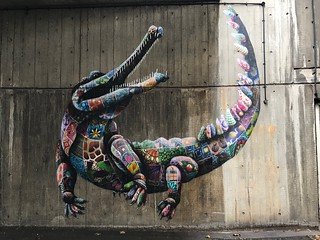 Now in my own writing, I tend to be pretty good about making my main characters into villains. I'm not sure why. Many writers will be protective of their main characters and make them so saintly they don't appear to be real people. I must be real crocodilian in my approach to character development, lol. I tend to want to throw my characters under the bus and have them appear to be unlikable. I am a big fan of the unlikable narrator, so that probably plays a part in it. Because I tend to lean heavily on the villain side of character development, I've used the drama triangle to make sure my characters also play hero and victim. This has saved me on a number of occasions by giving my character multiple dimensions.So there I am learning how capricorn in ancient astrology has these evolutionary patterns, and I'm a writer (the drama triangle is always floating around somewhere in the back of my mind). Suddenly, I think to myself, "What if I applied ancient astrology's approach with capricorn symbols to Karpman's model?" Then the villain becomes the crocodile, and the victim becomes the goat, and the hero becomes the unicorn. I've been gifted, aka cursed, with an overactive mind and imagination (great for storytelling but bad for peace of mind), so I suddenly start thinking in terms of "method acting."
Now in my own writing, I tend to be pretty good about making my main characters into villains. I'm not sure why. Many writers will be protective of their main characters and make them so saintly they don't appear to be real people. I must be real crocodilian in my approach to character development, lol. I tend to want to throw my characters under the bus and have them appear to be unlikable. I am a big fan of the unlikable narrator, so that probably plays a part in it. Because I tend to lean heavily on the villain side of character development, I've used the drama triangle to make sure my characters also play hero and victim. This has saved me on a number of occasions by giving my character multiple dimensions.So there I am learning how capricorn in ancient astrology has these evolutionary patterns, and I'm a writer (the drama triangle is always floating around somewhere in the back of my mind). Suddenly, I think to myself, "What if I applied ancient astrology's approach with capricorn symbols to Karpman's model?" Then the villain becomes the crocodile, and the victim becomes the goat, and the hero becomes the unicorn. I've been gifted, aka cursed, with an overactive mind and imagination (great for storytelling but bad for peace of mind), so I suddenly start thinking in terms of "method acting."
“Our demands are simple, normal, and therefore they are difficult to satisfy. All we ask is that an actor on the stage live in accordance with natural laws.” --
Konstantin Stanislavski begun the practice of method acting back in the early 1900s. The basic concept of the form is to "take on" traits of someone else or something else. This could mean an actor studying historical figures to such an intense degree that they "become" the person in behavior and thinking, like Kate Winslet in her portrayal of a former Nazi guard in The Reader. It also can mean an actor use the behavior of an animal to portray a specific depth, like Anthony Hopkins using traits of a lizard for his portrayal of serial killer Hannibal Lecter in The Silence of the Lambs.In the rapidity of an overactive imagination, I put the three together and started to make my drama triangle "character specific." So if my main character in my novel was like a spider in his villainy, then I asked myself: What animal would his victim and hero personas become? Or in astrological terms, what symbols would carry him through an evolutionary arch? If a crocodile can become a goat and then a unicorn, then a spider can become a bird and then a dragon.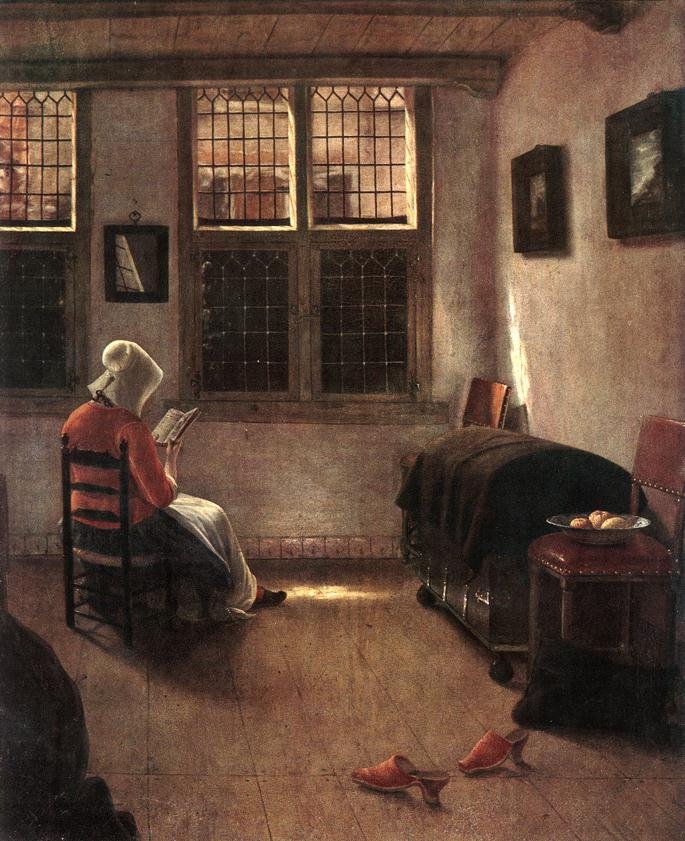 What's important to take away from this exercise is the freedom you obtain by marrying all three of these forms: drama triangle, evolutionary astrology, and method acting. By developing a "character specific" drama triangle, we as writers have a powerful tool to manifest complex characters out of thin air, like magicians mimicking the tools of a god. With the slight of hand, pencil and paper, screen and keyboard, we can hypnotize our audiences to feel as though they are participating in the lives of real people.
What's important to take away from this exercise is the freedom you obtain by marrying all three of these forms: drama triangle, evolutionary astrology, and method acting. By developing a "character specific" drama triangle, we as writers have a powerful tool to manifest complex characters out of thin air, like magicians mimicking the tools of a god. With the slight of hand, pencil and paper, screen and keyboard, we can hypnotize our audiences to feel as though they are participating in the lives of real people.
(Images were borrowed from pxfuel.com, maxpixel.com, flickr, and wikimedia commons)
#WritersLife: When Writers Dream of Characters in Their Novel
#WritersLife was the first thought I had when I woke. But I couldn't shake the deep depression taking control of me. I felt an immense sadness. It felt like I was so inadequate that I didn't matter to anyone. My life was so pointless and meaningless that no one would ever want to connect with me enough to care about my life. My mind kept circling around about how shitty a human being I was and how it didn't matter what I thought or felt. My chest was heavy, shoulders sunken, and I could feel the length of my jaw pulling downward. I had little energy. Just enough to zombie through the last two days.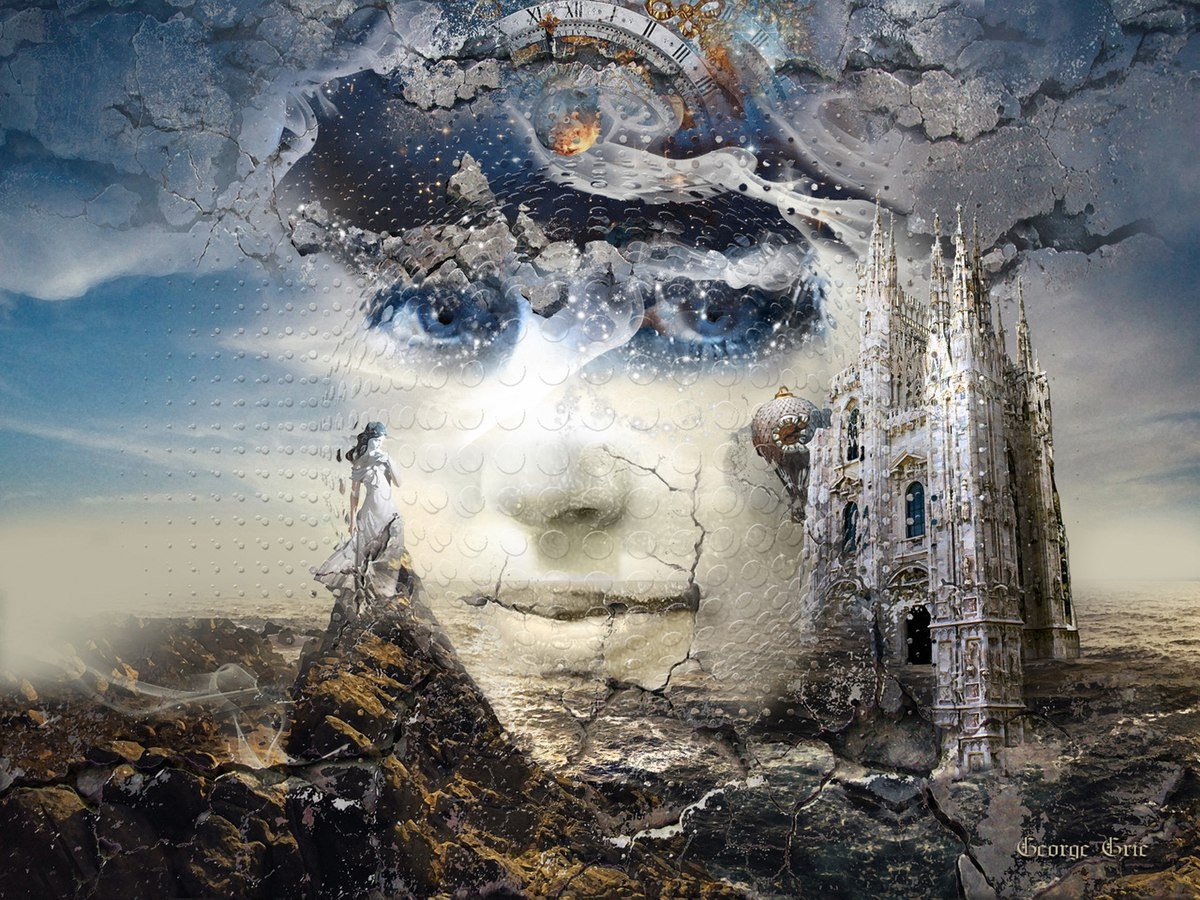 And it started with a vivid dream about a character, Jimena, in my novel, Unsettled Between.I've never had a reaction like this before. I've dreamt about characters and scenes and concepts for novels or short stories before (often in the waking moment between sleep and full consciousness), but I've never had such an emotional reaction. It's really odd and I'm still feeling remnants of it now. Yesterday was the worst of it.I'm not an emotional person. I get sad, but I don't tend to linger in it to a point I would call depression. I've been depressed before, but I tend to force myself into tasks that help alleviate those feelings. So when this feeling grabbed me over the last two days it was very alien, like someone else had stepped inside my body and had taken over.
And it started with a vivid dream about a character, Jimena, in my novel, Unsettled Between.I've never had a reaction like this before. I've dreamt about characters and scenes and concepts for novels or short stories before (often in the waking moment between sleep and full consciousness), but I've never had such an emotional reaction. It's really odd and I'm still feeling remnants of it now. Yesterday was the worst of it.I'm not an emotional person. I get sad, but I don't tend to linger in it to a point I would call depression. I've been depressed before, but I tend to force myself into tasks that help alleviate those feelings. So when this feeling grabbed me over the last two days it was very alien, like someone else had stepped inside my body and had taken over.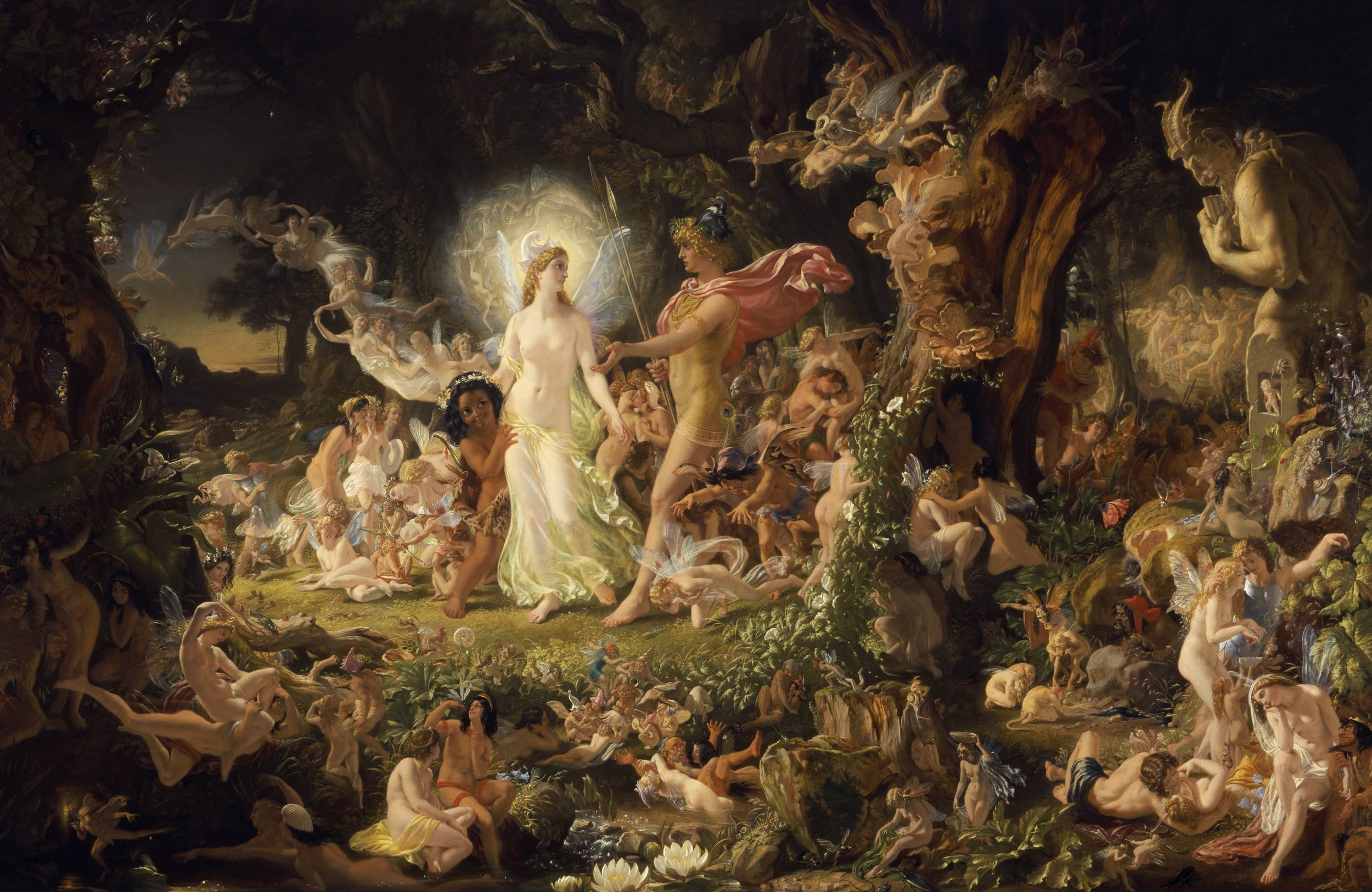 The dream was about me interacting with a character, Jimena. She's not a major character in my novel but she's important to certain stories in the collection.In the dream, Jimena lead me from one place to another but it was almost like I was floating around her as opposed to her leading me. It was like I took on her energy so she could act "normal" or front like she was okay. I watched as she displayed happiness and confidence to people around her, but I carried her sadness. That's weird, isn't it? How could I carry sadness for her?Another odd occurrence happened when I woke. There was a lightening flash that lit up my bedroom. It was so bright I thought it was storming outside. We had rain the day before so I thought maybe storms had come in overnight. But when I looked outside it was overcast but no storms. The flash was like a strobe coming from inside my room--not outside.Now I've carried this unbearable sadness with me for two days. The depression is so harsh that I haven't gotten on social media in the last two days. I'm a junkie or have bouts of social media binges so going two days with no interest in social media is odd. This is likely the case for many of us.
The dream was about me interacting with a character, Jimena. She's not a major character in my novel but she's important to certain stories in the collection.In the dream, Jimena lead me from one place to another but it was almost like I was floating around her as opposed to her leading me. It was like I took on her energy so she could act "normal" or front like she was okay. I watched as she displayed happiness and confidence to people around her, but I carried her sadness. That's weird, isn't it? How could I carry sadness for her?Another odd occurrence happened when I woke. There was a lightening flash that lit up my bedroom. It was so bright I thought it was storming outside. We had rain the day before so I thought maybe storms had come in overnight. But when I looked outside it was overcast but no storms. The flash was like a strobe coming from inside my room--not outside.Now I've carried this unbearable sadness with me for two days. The depression is so harsh that I haven't gotten on social media in the last two days. I'm a junkie or have bouts of social media binges so going two days with no interest in social media is odd. This is likely the case for many of us.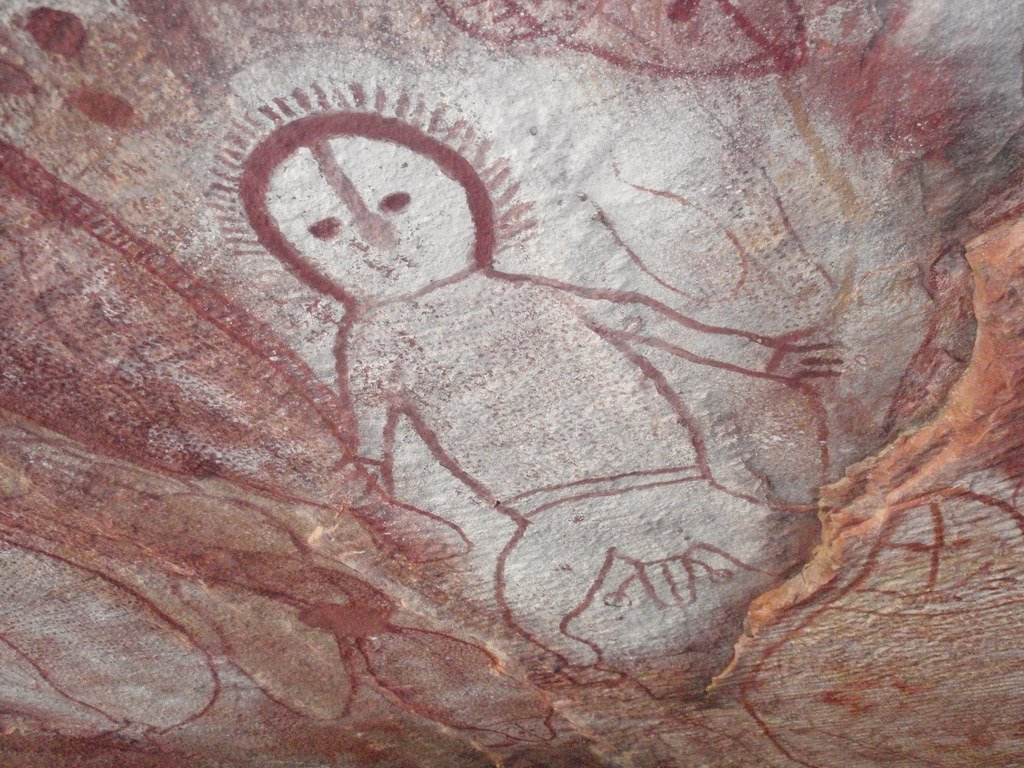 Initially, I tried to work this out as some residual part of my past, like something Jungian I hadn't addressed. But then suddenly I realized the character goes through something in the novel that was emotionally challenging for her. But I didn't give it the emotional weight. Meaning, maybe I wasn't honest enough about how much she hurt. I wish I could tell you what specifically I'm talking about in the novel, but I'm going to have to wait until it's released before I can put the two together.Ultimately, I feel like I didn't do her character justice and she came to me in my dream to show me how she felt. That sounds odd, I know. But I can't make sense of why I'd have these emotions associated to that dream about this specific character. It's the only conclusion I can draw.In fact, I had to write my agent, who received my most recent draft a couple weeks ago. I told her about the dream, and she gave me the green light to go back into the novel and revise Jimena's portion. I do feel better now that I can revise to Jimena's liking. But what an interesting emotional ride. As a writer, I sometimes feel like I know how to pull details from my psyche to write about. But this is a first.Have you dreamed about a character in one of your story lines? If so, what was your experience? A part of me is desperately searching for kindred spirits. I hope I'm not alone in this. I'm hoping this is one of those #WritersLife hashtag moments.
Initially, I tried to work this out as some residual part of my past, like something Jungian I hadn't addressed. But then suddenly I realized the character goes through something in the novel that was emotionally challenging for her. But I didn't give it the emotional weight. Meaning, maybe I wasn't honest enough about how much she hurt. I wish I could tell you what specifically I'm talking about in the novel, but I'm going to have to wait until it's released before I can put the two together.Ultimately, I feel like I didn't do her character justice and she came to me in my dream to show me how she felt. That sounds odd, I know. But I can't make sense of why I'd have these emotions associated to that dream about this specific character. It's the only conclusion I can draw.In fact, I had to write my agent, who received my most recent draft a couple weeks ago. I told her about the dream, and she gave me the green light to go back into the novel and revise Jimena's portion. I do feel better now that I can revise to Jimena's liking. But what an interesting emotional ride. As a writer, I sometimes feel like I know how to pull details from my psyche to write about. But this is a first.Have you dreamed about a character in one of your story lines? If so, what was your experience? A part of me is desperately searching for kindred spirits. I hope I'm not alone in this. I'm hoping this is one of those #WritersLife hashtag moments.
Support a Native owned Etsy shop, Allies United, where I offer unique merch for allies of social justice movements, like MMIW, Native Lives Matter and Black Lives Matter. Take a look inside my Etsy shop here: etsy.com/shop/AlliesUnited.
(Images were borrowed from wikimedia, wikipedia, and flikr)
On Writing an "Indian Child Welfare" Novel & Other Grand Adventures
I hiked into the Grand Canyon. I must've been in my late twenties, maybe early thirties. It started out as a walk to look over the rim. I had camped the night before in a tent at one of the sites and woke early (probably about 5am). I was there with a friend and she was still asleep. As the sun rose out of the east, I decided to follow the paved roads toward the rim of the Grand Canyon. It was nice to be out so early in the morning. No one was around. It felt like the entire world was mine alone. I strolled on the sidewalk lining the edge of the Grand Canyon mesmerized by the depth of the canyon and the streaming sunlight slowing filling it's center. It was beautiful, magical, and most of all peaceful.Then I happened upon an entrance. I didn't expect to find an invitation that day.
It was nice to be out so early in the morning. No one was around. It felt like the entire world was mine alone. I strolled on the sidewalk lining the edge of the Grand Canyon mesmerized by the depth of the canyon and the streaming sunlight slowing filling it's center. It was beautiful, magical, and most of all peaceful.Then I happened upon an entrance. I didn't expect to find an invitation that day.
“You can always edit a bad page. You can't edit a blank page.” ―
Similarly, I find stories as I stroll through my everyday. I'm always vigilant and, after being trained by the Institute of American Indian Arts and the University of Oklahoma, I see every moment as a beginning, middle, and end (a story).I've said this before. I write what I live, and create fiction by moving experiences around, compounding memories, and enhancing the "feeling" of a moment with embellishments. But embellishments can be made into entertainment when delivered as a book-sized package.I have three writing projects at the moment. Those of you who follow my blog likely know about two of those projects. The development of my novel, Uncle Called Him Spider, has been highlighted on this blog, and you can go back and find the collapse and expansion of those words in posts such as Gossip: Weapon of the Weak. It's in full first draft mode. I've revised a little but I've put it on hold. In fact, the reason I put it on hold lead me to another novel, or a novel-in-stories: Unsettled Between.
“A short story I have written long ago would barge into my house in the middle of the night, shake me awake and shout, 'Hey, this is no time for sleeping! You can't forget me, there's still more to write!' Impelled by that voice, I would find myself writing a novel.” ―
Unsettled Between began a decade ago. It's ten years in the making. I wrote one of it's first stories, Our Dance, with the help of instructors and classes at the Institute of American Indian Arts--this was around 2008. It was then published in 2010 with American Short Fiction. Then I developed another of it's stories, Time Like Masks, while completing my Master's Degree at the University of Oklahoma. It was picked up by South Dakota Review in 2011. Now, those stories are two of twelve in my novel, Unsettled Between. I'm proud to say it's rep'd by Allie Levick of Writers House.This brings me to the third project. This one is very recent. I'm calling it my "Indian Child Welfare" novel, as I develop the story-line to completion. As I had with Uncle Called Him Spider, I'll be brainstorming different components of the novel here on my blog. So be sure to click the "follow" button (not to sound too much like a YouTube video). I'm not going to give away much detail on this story. I tend to hold off on full disclosure until the novel has reached fruition. But as you read posts you'll be able to piece together what I'm struggling with, as far as what I need to capture, and where the novel is headed.
“You write about experiences partly to understand what they mean, partly not to lose them to time. To oblivion. But there's always the danger of the opposite happening. Losing the memory of the experience itself to the memory of writing about it.” ―
But I will say this: I've outlined 25 chapters and have developed a full synopsis of the novel at this point. I've worked out details that drive the action. But I've not written the first draft. That's my next step. So be sure to come back and check in. You'll find my frustrations and triumphs listed here. Often my brainstorming sessions show up at odd and unpredictable times. I'll also add: The world of child welfare is not what you think. I've worked for over ten years with at-risk populations and you might believe heroism has a certain purist quality to it, but I'll dispel that for you. I have a cast of characters in this "Indian Child Welfare" novel that'll both affirm and disrupt your belief in how people carry themselves in this field. When I say you'll be shocked, it's not about the obvious things. I don't dabble in the obvious. I advocate to "bare witness" to the unseen. No more secrets.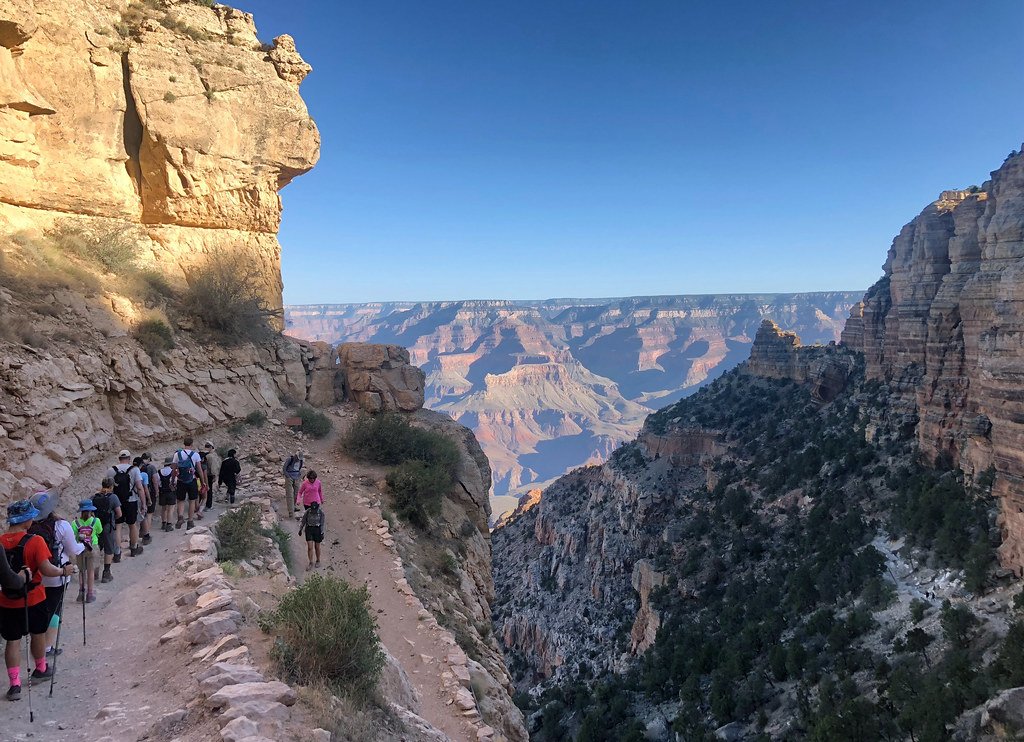 So back to my trek into the Grand Canyon. I hiked halfway down that day. I passed people hiking back up (exhaustion on their faces) and people riding donkeys (scary). It was beautiful watching the morning light grow into full afternoon. At the halfway point, there was a watering station. I filled my water bottle, sat next to other hikers in the shade, and contemplated on how easy it was to climb down.I realized that around four hours had passed and I needed to get back to camp. I hadn't told my companion that I was leaving. She was still asleep. I didn't want to wake her. Besides, I thought I was going on a light walk to the rim and back. Surely, I'd have returned before she woke. Then I ended up halfway down into the Grand Canyon. Needless to say, I drank as much water as my stomach could hold, refilled my water bottle, and started the trek back up.Three steps into climb and I thought, "Oh shit, what did I get myself into?" My legs suddenly grew tight and each step became work. I had used a different set of muscles to cruise down the edges of the canyon. Now I had to use larger muscles to climb up. Long story short, six hours later I finally pulled myself out of the canyon and back to the rim. If not for a kind and generous young man, who walked a good portion of the hike alongside me, maybe it would've take me longer. He was ten years younger and already a good conversationalist. Somehow I made it back to the rim and, by the time I made it back to camp, the sun was starting to set in the west.
So back to my trek into the Grand Canyon. I hiked halfway down that day. I passed people hiking back up (exhaustion on their faces) and people riding donkeys (scary). It was beautiful watching the morning light grow into full afternoon. At the halfway point, there was a watering station. I filled my water bottle, sat next to other hikers in the shade, and contemplated on how easy it was to climb down.I realized that around four hours had passed and I needed to get back to camp. I hadn't told my companion that I was leaving. She was still asleep. I didn't want to wake her. Besides, I thought I was going on a light walk to the rim and back. Surely, I'd have returned before she woke. Then I ended up halfway down into the Grand Canyon. Needless to say, I drank as much water as my stomach could hold, refilled my water bottle, and started the trek back up.Three steps into climb and I thought, "Oh shit, what did I get myself into?" My legs suddenly grew tight and each step became work. I had used a different set of muscles to cruise down the edges of the canyon. Now I had to use larger muscles to climb up. Long story short, six hours later I finally pulled myself out of the canyon and back to the rim. If not for a kind and generous young man, who walked a good portion of the hike alongside me, maybe it would've take me longer. He was ten years younger and already a good conversationalist. Somehow I made it back to the rim and, by the time I made it back to camp, the sun was starting to set in the west. I apologized profusely to my companion, but she was kind about it all and made her own adventures that day. She, an artist herself, knew the flights of fancy we creative types tend to have. To this day, I can find myself on peculiar adventures at a moment's notice. And like novel writing, we stumble upon an entrance and dare ourselves to take the invitation. When we think we've completed the journey, we look up and find our challenge is only halfway complete. So here's to the next few steps.
I apologized profusely to my companion, but she was kind about it all and made her own adventures that day. She, an artist herself, knew the flights of fancy we creative types tend to have. To this day, I can find myself on peculiar adventures at a moment's notice. And like novel writing, we stumble upon an entrance and dare ourselves to take the invitation. When we think we've completed the journey, we look up and find our challenge is only halfway complete. So here's to the next few steps.
(Images were borrowed from flickr, pxhere, and wikipedia)
Novel DNA: How Writing Chapters can Change the World
What to do with a great idea? Let's sit down and map out a novel. Writing in the dark is a popular way of writing short stories. We get an idea. We pull out the laptop. We write until everything is on the page. As we write, we don't know where the story will lead and this suspense and feeling of surprise keeps us writing, it builds adrenaline, and keeps us guessing as we finish a story. But there may need to be a different approach when it comes to a 25 chapter novel.
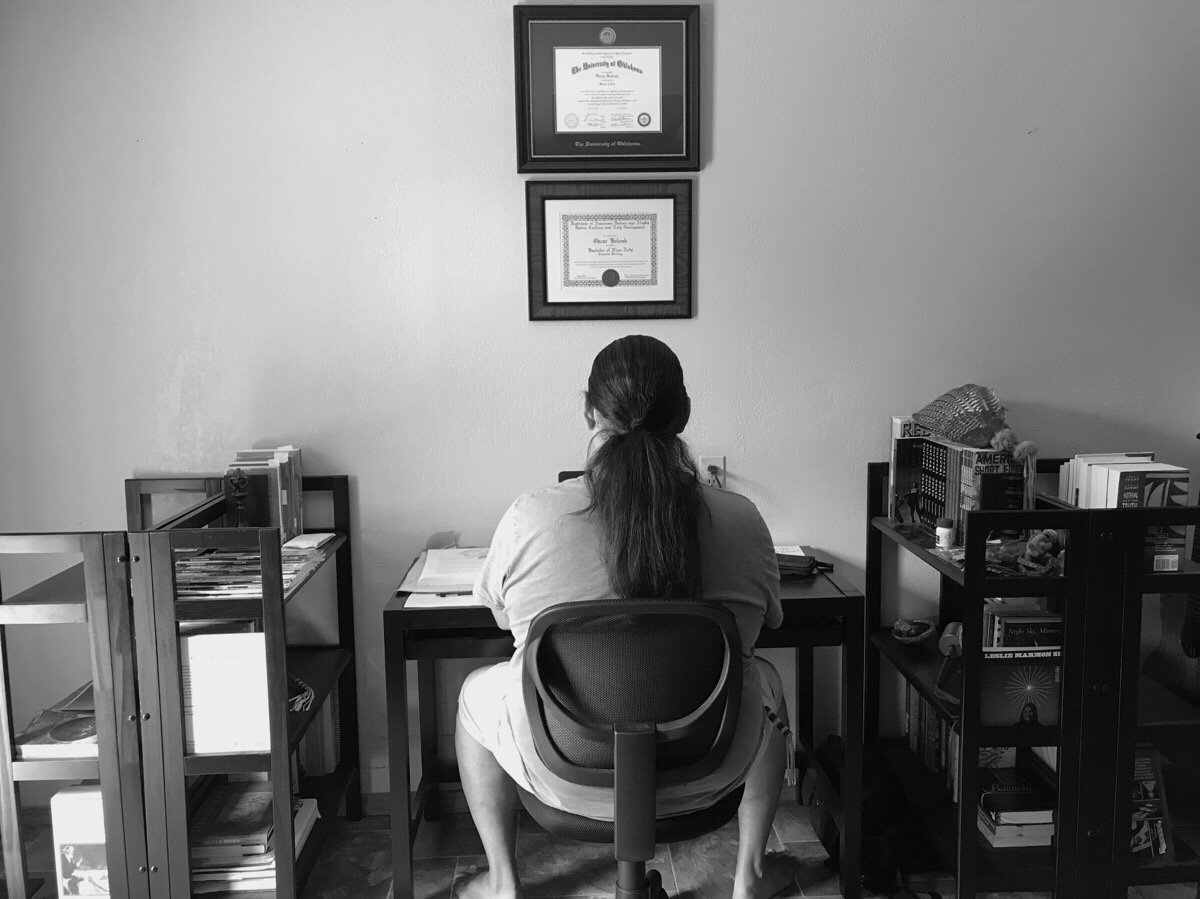
I'm not going to tell anyone how to write. We all have our nuanced approach. But what I'm going to do is share with you how I go about writing my novels. And where novel writing can be different and similar to short story writing. We've all gotten to the point where we've asked ourselves: How do I write a novel? Do I outline? If so, how do I outline multiple chapters to create an interesting story arch? Do I write in the dark for 80,000 words? If so, will my novel have deadly and boring lulls?
Do a little cross compare with my approach and fill in with your personal style. Make the process your own. That's one of the important components to any creative approach.
First thing I do: Create a OneNote file. The tabs work great to create space for each individual chapter. I always have a "development" tab, where I create multiple pages for subjects like characters, plot, subplots, story arch, etc. But I create a tab for each chapter so I can brainstorm elements within each chapter. What I need to consider for one chapter is not going to work for another. If there is a clear build up and tension to the novel, then every chapter will need a lot of space to create the nuances.
Example: If the main character is taking a child into custody in the first chapter, then I'll need space to brainstorm her approach, which will be determined by the other characters confronting her and how she will overcome that confrontation. This is radically different than the second chapter, where the main character might be confronting a whole different situation, like children adjusting to a new foster home.
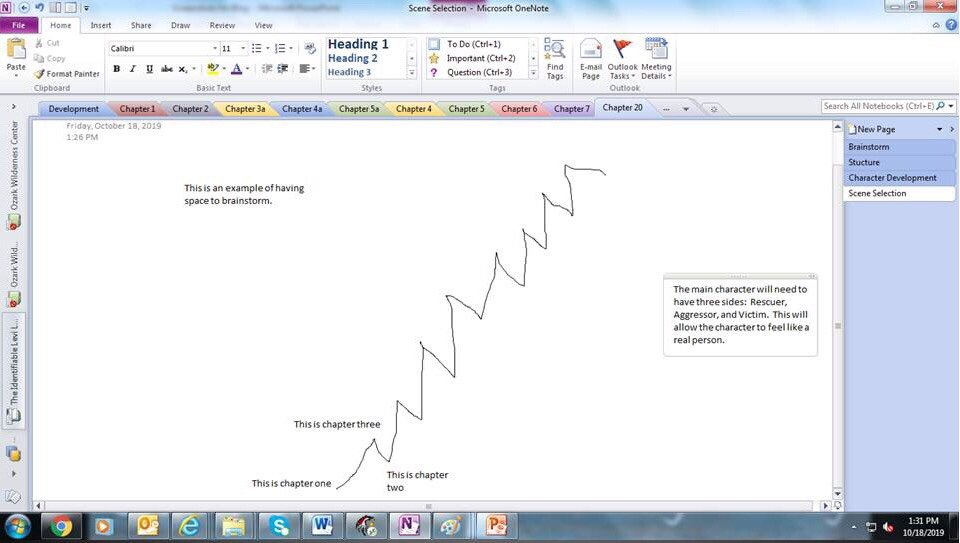
Also, I like to have all the tools in OneNote. I can draw out the build up as you can see in the image above. I can also write text boxes for each idea I need to address for development. I can also move those boxes around.
So once I have the space established to develop my novel, I then go into writing a "synopsis" of sorts. It's a line by line breakdown of the novel. It's not a full synopsis by any sorts but it gives me a quick snapshot of the progression of the main character's obstacles. Also it gives me an opportunity to consider subplots. In a novel, it's important to establish subplots that mirror or give us a break from the main story line.
Example: If the main character is a young man who is trying to overthrow his corrupt boss, then the reader will need to take a break from the ugliness transposed between the two. We can see him with his family and his family gives him stress relief as he battles with this boss, but it will simultaneously show the family putting pressure on him to be successful at work. The subplot shows a different side to this young man, and it also adds to the tension while giving the reader an alternate storyline to follow.
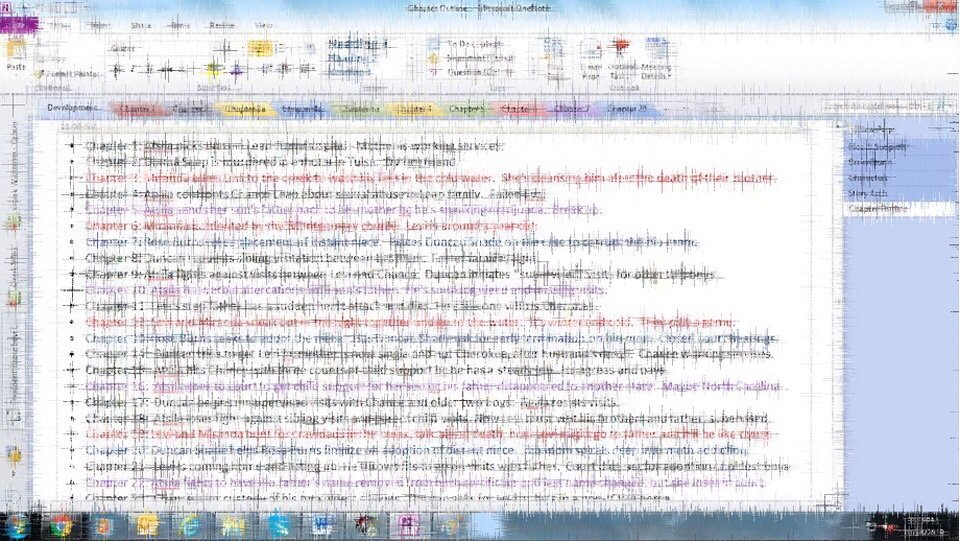
So I had to "shear" the screen because the above image is a screenshot from the current novel I'm working on. I don't want to give away any details in the novel before it reaches fruition. But as you can see in the above image, it shows a "list" of each chapter from chapter one to chapter 25. I'd also like for you to notice the different colors on each line. There are chapter breakdowns in black, red, blue, and purple. The black represents the main plot line, the red is a tightly related subplot (a subplot closely aligned with the main plot), while the blue and purple are subplots that show a seperate but nuanced mirror to the main plot (gives the reader an emotional "break" from the plot while also increasing tension).
You're probably asking why I go to such lengths to map out my novels. For me the pleasure of writing isn't only in the initial creation of a piece. I like the practice of "writing in the dark" when it comes to short stories. But when we're trying to hold someone's attention for a long period of time, there needs to be numerous components to keep the reader entertained. This is the reason I write. For other people to have as much pleasure reading the novel as I had creating it. When it's two fold, we as writers get more in return because then we have happy fans who are eager to talk about and share our writing. In order to reach that goal, there is a lot of layers to create.
I enjoy the macro development as much as the micro. As I create the big picture, outlining chapter by chapter how the main character will survive all the obstacles I throw in her way, the concept building can be euphoric. It's a physical reaction. After I've written the first draft and I'm finally ready for the details (the micro), I'm getting adrenaline from witnessing the spirit of the novel come alive in the words. Suddenly, my idea that corruption can be beaten becomes emotionally tangible when the main character throws a fist full of contracts into an evil boss's face. It all comes together.
There is nothing more exciting than seeing the DNA of a novel build word by word into a complex living system. And it takes hard mental labor to structure a story so perfectly that someone can read your work and suddenly choose to transform their worldview to include people you know and experiences you've lived. To make that connection, it's worth all the time, thought, and energy spent.
Support a Native owned Etsy shop, Allies United, where I offer unique merch for allies of social justice movements, like MMIW, Native Lives Matter and Black Lives Matter. Take a look inside my Etsy shop here: etsy.com/shop/AlliesUnited.
Colloquial Traits in Tribal Regionalism
Often I sit here in front of this computer and think about how to capture the voice of a narrator. Voice is the darkness around the thief, his soft footsteps, and his choice of victim. There is nothing innocent about what we writers do. We're persuasive colonizers seeking to intrude on your sensibilities. We're convincing--softly so.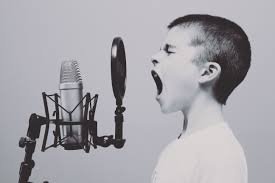 When I read passages from Faulkner's work and observe the way he captured southern diction, I can't help but be humbled. The small pauses and grand judgements alike--all are done with a slight of hand I wish to master.
When I read passages from Faulkner's work and observe the way he captured southern diction, I can't help but be humbled. The small pauses and grand judgements alike--all are done with a slight of hand I wish to master.
“In a strange room you must empty yourself for sleep. And before you are emptied for sleep, what are you. And when you are emptied for sleep, what are you. And when you are emptied for sleep you are not. And when you are filled with sleep, you never were. I don't know what I am. I don't know if I am or not.” ― William Faulkner, As I Lay Dying
I've taken the task to implement something similar with my two tribal communities. I've sought to capture the way Kiowa and Cherokee people speak as the chosen "voice" for my narration. Why? It's not just because I was raised in these two communities, but that is a major reason. When you grow up between two tribal cultures, especially two which are historically set in two different landscapes (southern plains versus mountain/hills), you can't help but recognize the beautiful differences.My writing has always attempted to disrupt the homogenous stereotype of Native people belonging to the same culture (and often a culture perceived to be plains). It's important to know there are unique differences between each tribal culture and we are brought together by a common and shared history of colonialism. The continued struggle against this colonial force has further fused our identities in a universal Pan-Indian construct. But the differences in our languages, dances, songs, customs, social etiquette hasn't vanished.In the case of my writing, we can also include colloquialism.Kiowa and Cherokee people share colonial boundaries by having been transplanted into what was formerly known as Indian Territory (the largest prisoner of war camp in recorded history), which is now Oklahoma. Kiowa people live on the southern plains while Cherokee people live in Ozarks. But both tribes are in Oklahoma. Not only are my tribes divided by geographical topography but also language, culture, and tribal history. Before the reservation era, Kiowa people were nomadic and situated in a warrior culture (a part of a tribal plains coalition which held off the U.S. government from westward expansion for over 100 years), and Cherokee people were agrarian mountain people (who spear-headed major legal battles with the U.S. government generations before plains Natives seen their first U.S. soldier).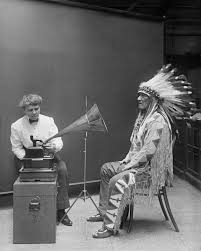 As a writer, my attempt is to show this distinction by way of vernacular. In the way you read Faulkner's representation of Southern culture in the above passage, I take the Oklahoman way in which Cherokee people speak that's indicative of small towns in the Ozarks of northeastern Oklahoma and northwestern Arkansas. To contrast, I take an Indigenized English through Kiowa language to capture how tribes on the southern plains speak.Below I give an example from two different short stories. Time Like Masks (published in South Dakota Review) captures the Okie twang that is characteristic of how Cherokee people speak in my community of Tahlequah. Our Dance (published in American Short Fiction) captures an Indigenized English which is not only indicative of how Kiowa people speak, but Comanche and Apache on the southern plains.Cherokee/Tahlequah:
As a writer, my attempt is to show this distinction by way of vernacular. In the way you read Faulkner's representation of Southern culture in the above passage, I take the Oklahoman way in which Cherokee people speak that's indicative of small towns in the Ozarks of northeastern Oklahoma and northwestern Arkansas. To contrast, I take an Indigenized English through Kiowa language to capture how tribes on the southern plains speak.Below I give an example from two different short stories. Time Like Masks (published in South Dakota Review) captures the Okie twang that is characteristic of how Cherokee people speak in my community of Tahlequah. Our Dance (published in American Short Fiction) captures an Indigenized English which is not only indicative of how Kiowa people speak, but Comanche and Apache on the southern plains.Cherokee/Tahlequah:
"Come to find out, he was the grandson to my aunt Josie, who was the sister to my mother, Leanna. According to Cherokee clan customs, Carl was a nephew, a nephew through a first cousin I hardly knew. Guess that was how relations grew as old got older—more years, more kin. My aunt Josie went and married a Kiowa and spent most of her days living in southern Oklahoma; I never visited so I hardly seen my cousins, much less their kids. Carl, on the other hand, made himself known to me in a peculiar way. Unlike others, I listened to him, and you might say, at least how I figured, he baffled everyone." --Oscar Hokeah in Time Like Masks
Kiowa/Lawton:
"Gaa, we were just little guys, around a year old, when Kiowas started getting that ahongiah back in ’76, no, maybe in ’77. It was the coalition of Kiowas, Comanches, and Apaches that leased a tract of land to Fort Sill military base for one hundred years. Good thing, too, because us Kiowas divided our share of the money between all tribal members, fifteen hundred a piece. Those of us under the age of eighteen had our money held in trust, growing interest until our day. We were the last in our families to walk through the front doors of those cookie-cutter homes to hear our mothers say, 'Your per cap check is on the table.'" --Oscar Hokeah in Our Dance
The trick isn't just to capture the nuances in the speech pattern, but to also transfer it to literature. When we tell a story face-to-face we're filled with excessive pauses and added words to fill time and space for us to think as we speak. When transforming a vernacular to the page, you must take out enough and leave in enough to capture the intended identity. This is not easy. It took me years to find the right balance.But all this goes toward showcasing the beautiful differences between Kiowa and Cherokee culture. There are a number of other things I do--some obvious and some subtle--to further capture the difference, but this post is about voice so I wanted to speak directly about vernacular in my tribal communities and in my writing. As we move to an appreciation of diversity in America, we can further appreciate the complexity of tribal cultures.The two above examples are a part of my novel-in-stories, Unsettled Between. I'm deep in a final revision right now and tightening up character and voice. The novel is narrated by twelve different family members and focuses on the transformation of one character, Carl Geimausaddle. Like so many of us, Carl wants the freedom to be his own person, to shape his own identity. He attempts to do so by leaving his family and rejecting his Kiowa and Cherokee communities. But will life struggles allow him his freedom? Unsettled Between examines how identity is at the mercy of community and the inseparable bond we have with the people who love us the most.Unsettled Between is Rep'd by Allie Levick of Writers House Literary Agency.
Support a Native owned Etsy shop, Allies United, where I offer unique merch for allies of social justice movements, like MMIW, Native Lives Matter and Black Lives Matter. Take a look inside my Etsy shop here: etsy.com/shop/AlliesUnited.
Lies, Love, & Magic: How Voice was Hijacked by Editor Mysticism & Workshop Critique BS!
The sought after and mysterious "voice" of writing. You watch editors salivate like Derridean defeatists about how magical voice can be when it "makes your foot tap to the rhythm." Aww, how romantic. We are lovely romantic beings who need magic in our lives. Well, I'm about to take the magic out of the what, where, and how to find a literary voice. For writers, we don't give a shit about magic. Our job is to deconstruct the process and lay it all out for other writers. We are here to help each other learn the tricks to make the magic happen for readers, which is why editors love to talk about the mysterious quality of writing. Because ultimately they are fans of literature. They are readers. We reader/writers--the ones who create the magic--must abandon all notions of romanticism. We're here to work. Why? Because we love the secrets of writing as much as we love the process. Because we love to make the magic and watch the readers read in awe.So if you've hit the google machine with a "how to find your voice" or "what is voice in literature" or "what is a writer's voice" then you've come to the right spot. I'm about to break this bad boy down.First and foremost I need to tell you what voice is not. So when we go to write we need the reader to see what we see as writers. The reader needs to be able to visualize the scenes as they play out in the course of our short story or novel. That is the action. That is description. The nuts and bolts.
For writers, we don't give a shit about magic. Our job is to deconstruct the process and lay it all out for other writers. We are here to help each other learn the tricks to make the magic happen for readers, which is why editors love to talk about the mysterious quality of writing. Because ultimately they are fans of literature. They are readers. We reader/writers--the ones who create the magic--must abandon all notions of romanticism. We're here to work. Why? Because we love the secrets of writing as much as we love the process. Because we love to make the magic and watch the readers read in awe.So if you've hit the google machine with a "how to find your voice" or "what is voice in literature" or "what is a writer's voice" then you've come to the right spot. I'm about to break this bad boy down.First and foremost I need to tell you what voice is not. So when we go to write we need the reader to see what we see as writers. The reader needs to be able to visualize the scenes as they play out in the course of our short story or novel. That is the action. That is description. The nuts and bolts.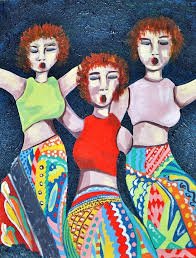 For example, if I write, "Dean took a step forward and gazed at the interesting ropes above." That is me describing action. This is the story. I'm going to say that again and put it in bold letters for emphasize. Okay, here goes: Action is the story. This is not the voice. The story is the most important part of writing. Not voice. I'll dispel voice in this post and then you can get to the real work: writing the story. It is the first and last thing you need to be thinking about when writing your short story or novel. You need to be focused on scene selection. Select your scenes in the sequence in which lays out the action to conclude on the climax. Scenes are the walls and floors of the house. Action and description are the nails and mortar holding the walls and floors together.Now it's time to decorate the house. Now "voice." Ready to dilute your desperate need for magic. Ready to grow up as a writer. Here goes. Voice is simply the insight, wisdom, and judgements of the narrator.So now I can hear people yelling at the computer screen. You need to take a breath. Life is not that hard. Take a minute and let me elaborate. I'll prove myself right. Oh, no wait, I'll allow you your "voice" and let you be the judge of that.
For example, if I write, "Dean took a step forward and gazed at the interesting ropes above." That is me describing action. This is the story. I'm going to say that again and put it in bold letters for emphasize. Okay, here goes: Action is the story. This is not the voice. The story is the most important part of writing. Not voice. I'll dispel voice in this post and then you can get to the real work: writing the story. It is the first and last thing you need to be thinking about when writing your short story or novel. You need to be focused on scene selection. Select your scenes in the sequence in which lays out the action to conclude on the climax. Scenes are the walls and floors of the house. Action and description are the nails and mortar holding the walls and floors together.Now it's time to decorate the house. Now "voice." Ready to dilute your desperate need for magic. Ready to grow up as a writer. Here goes. Voice is simply the insight, wisdom, and judgements of the narrator.So now I can hear people yelling at the computer screen. You need to take a breath. Life is not that hard. Take a minute and let me elaborate. I'll prove myself right. Oh, no wait, I'll allow you your "voice" and let you be the judge of that. So let's take the previously used example and rearrange it. Go back up and read if necessary. It was straight forward description. Now if I insert voice it might sound like, "Dean impulsively stepped forward (might know)--did his best to understand the intersecting ropes above." So with the quick insertion of an adjective "impulsively" and a quick but subtle judgement "did his best" I've cast judgement on Dean's actions. And the addition of (might know) is a Kiowa cultural judgment, so the "voice" is Kiowa and it is being judgemental of Dean's action.You can follow up the sentence with a bit of judgemental wisdom and add, "Still a monsape tali for his age (mid twenties) and you know how they say tali brains don't develop as fast a mautaun." So I've inserted a lot of Kiowa language into that one sentence but you can quickly assess by context the "voice" is making a judgement on the main character. By deduction and pop culture, you participate in the reading and deduce tali means boy and mautaun means girl. Why? Because it's commonly understood male brains develop slower than female brains.All I did was use judgement, insight, and wisdom. That's it. Nothing else. I did a little sentence play, and did my hyperlocal thing (indicative of my writing style). But I argue this: those pauses don't come until first you cast judgement, insight, and wisdom. I believe this to my core. So much so, I challenge you to take a straight forward sentence in your own story, add judgement (good or bad, love or hate doesn't matter), and all of a sudden you'll start putting in pauses and/or running sentences long. It is the judgement, insight, and wisdom that shapes the sentence. Hear me say that again: It is the judgement, insight, and wisdom that shapes the sentence.The Kiowa and hyperlocal tone all comes from judgement, insight, and wisdom. All our families and communities have it regardless of culture. In fact, as my mind starts to process the three aspects I mentioned, the tone of the community comes out. It is taking our mind space and inserting the value judgements which are already imbedded in us and using it as a tool to rearrange sentences. That's how you get those amazing sentences the great writers write, and that's how they developed their "voice."My favorite writers are N. Scott Momaday, Louise Erdrich, Gabriel Garcia Marquez, Alice Munro, and Junot Diaz. Take your pick. Go read their work, and then come back to me and tell me I'm wrong. In fact, I dare anyone to try to argue differently.
So let's take the previously used example and rearrange it. Go back up and read if necessary. It was straight forward description. Now if I insert voice it might sound like, "Dean impulsively stepped forward (might know)--did his best to understand the intersecting ropes above." So with the quick insertion of an adjective "impulsively" and a quick but subtle judgement "did his best" I've cast judgement on Dean's actions. And the addition of (might know) is a Kiowa cultural judgment, so the "voice" is Kiowa and it is being judgemental of Dean's action.You can follow up the sentence with a bit of judgemental wisdom and add, "Still a monsape tali for his age (mid twenties) and you know how they say tali brains don't develop as fast a mautaun." So I've inserted a lot of Kiowa language into that one sentence but you can quickly assess by context the "voice" is making a judgement on the main character. By deduction and pop culture, you participate in the reading and deduce tali means boy and mautaun means girl. Why? Because it's commonly understood male brains develop slower than female brains.All I did was use judgement, insight, and wisdom. That's it. Nothing else. I did a little sentence play, and did my hyperlocal thing (indicative of my writing style). But I argue this: those pauses don't come until first you cast judgement, insight, and wisdom. I believe this to my core. So much so, I challenge you to take a straight forward sentence in your own story, add judgement (good or bad, love or hate doesn't matter), and all of a sudden you'll start putting in pauses and/or running sentences long. It is the judgement, insight, and wisdom that shapes the sentence. Hear me say that again: It is the judgement, insight, and wisdom that shapes the sentence.The Kiowa and hyperlocal tone all comes from judgement, insight, and wisdom. All our families and communities have it regardless of culture. In fact, as my mind starts to process the three aspects I mentioned, the tone of the community comes out. It is taking our mind space and inserting the value judgements which are already imbedded in us and using it as a tool to rearrange sentences. That's how you get those amazing sentences the great writers write, and that's how they developed their "voice."My favorite writers are N. Scott Momaday, Louise Erdrich, Gabriel Garcia Marquez, Alice Munro, and Junot Diaz. Take your pick. Go read their work, and then come back to me and tell me I'm wrong. In fact, I dare anyone to try to argue differently.
Support a Native owned Etsy shop, Allies United, where I offer unique merch for allies of social justice movements, like MMIW, Native Lives Matter and Black Lives Matter. Take a look inside my Etsy shop here: etsy.com/shop/AlliesUnited.
(Images used in this post are not the property of the author. They were borrowed from Wikipedia, PxHere, and Pixabay)
Seeing through Layers like Blankets on a Cold Night
My father was am immigrant from Mexico. My mother a full blood Kiowa/Cherokee from Oklahoma. They worked the peanut and cotton fields when my sisters and I were young. I remember ducking the large rolling water sprayers in the fields; I remember the heat coming from the dirt onto my bare feet; and I remember living in abandoned farm houses in the Oklahoma fields. Let me tell you about cold nights. No, better yet, let me tell you about the warmth you can have from the thin layer of a blanket.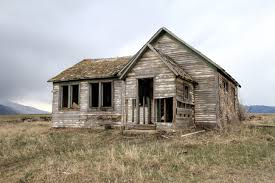 As I make progress through the revision stage of my novel, Uncle Called Him Spider, I visualize odd and peculiar moments in my life. Here I am thinking about point of view, analyzing the spaces between first person narrative and third person limited omniscience, and I start to make the comparison of that space to the thin layer of a blanket on a cold night. Then I remember the farm houses.Odd how the memory works.So a few days ago I was living through a fictional space in my mind where I envisioned someone asking me, "Why did you write Uncle Called Him Spider in third person limited omniscient instead of first person?" They would go onto explain how the two forms aren't very far apart structurally. So many great novels are written in the first person. Yes, I actually visualize conversations like this. And, yes, I'm only a breath away from insanity, but only the good writers are.
As I make progress through the revision stage of my novel, Uncle Called Him Spider, I visualize odd and peculiar moments in my life. Here I am thinking about point of view, analyzing the spaces between first person narrative and third person limited omniscience, and I start to make the comparison of that space to the thin layer of a blanket on a cold night. Then I remember the farm houses.Odd how the memory works.So a few days ago I was living through a fictional space in my mind where I envisioned someone asking me, "Why did you write Uncle Called Him Spider in third person limited omniscient instead of first person?" They would go onto explain how the two forms aren't very far apart structurally. So many great novels are written in the first person. Yes, I actually visualize conversations like this. And, yes, I'm only a breath away from insanity, but only the good writers are. It's a good question. I'm glad the fictive personality in my mind asked. Why third over first? I think it goes back to the blanket on the cold night. So what does first person perspective do? It pulls the reader in close. You are directly inside the narrator's mind and you are watching what the narrator watches. You only experience what the narrator feels. You are under the blanket.So you're going to argue third person limited does the same thing. But I'm going to disagree with you. It does put you, the reader, inside the main character's mind. Yes, you feel what she feels and you get to hear her thoughts. But there is one thing first person doesn't offer: Freedom.With just a thin layer of distance, third person limited omniscient gives the reader a power lost to the first person POV. Because you are subconsciously noticing the "he said, she said" aspect of the writing, you are then subconsciously implementing the "he said, she said" mentality. Meaning? You cast judgment more readily. You are less likely to identify with the main character and more likely to criticize her.
It's a good question. I'm glad the fictive personality in my mind asked. Why third over first? I think it goes back to the blanket on the cold night. So what does first person perspective do? It pulls the reader in close. You are directly inside the narrator's mind and you are watching what the narrator watches. You only experience what the narrator feels. You are under the blanket.So you're going to argue third person limited does the same thing. But I'm going to disagree with you. It does put you, the reader, inside the main character's mind. Yes, you feel what she feels and you get to hear her thoughts. But there is one thing first person doesn't offer: Freedom.With just a thin layer of distance, third person limited omniscient gives the reader a power lost to the first person POV. Because you are subconsciously noticing the "he said, she said" aspect of the writing, you are then subconsciously implementing the "he said, she said" mentality. Meaning? You cast judgment more readily. You are less likely to identify with the main character and more likely to criticize her.
"The omniscient narrator is a bizarre technique, when you think about it, and no one uses it much anymore. But for the novels I want to write, it's the only approach that makes sense to me." -- by Min Jin Lee
Why? It's space. Being on the outside of the blanket you still feel the cold night, while the main character is cozy under the blanket. There's enough distance to analyze and criticize situations as the main character moves through the storyline. In essence, it empowers the reader to make their own conclusions without the main character trying to convince them otherwise.I'm going to take this a little deeper--just for food for thought. I think it may be an issue of control. If an author wants you to think a certain way about a character she will do anything and everything to persuade you, like using first person narration. Now, don't get upset at me for making this claim. If you go read the three free short stories on my website, you'll find three first person short stories. I write first person. But as I think about the novel I'm writing I can't help but wonder how much of it has to do with authorial control over the reader. Maybe I'm in a space of letting go, ready to give readers their freedom so I can have my own. Or...maybe I think way too much about this shit. :)
Support a Native owned Etsy shop, Allies United, where I offer unique merch for allies of social justice movements, like MMIW, Native Lives Matter and Black Lives Matter. Take a look inside my Etsy shop here: etsy.com/shop/AlliesUnited.
(The images used in this post were borrowed from Wikimedia and Wikipedia)
(Images were borrowed from pexels.com and terrain.org)
Main Character Slam, Drop, Kick!
Revision is a little punk b#?ch! There I am toiling away on the second draft, almost to the end of the novel and starting to think about characters in the novel (mentally preparing for the "sweeps" portion of my revision process), and then I come to realize my main character is an asshole.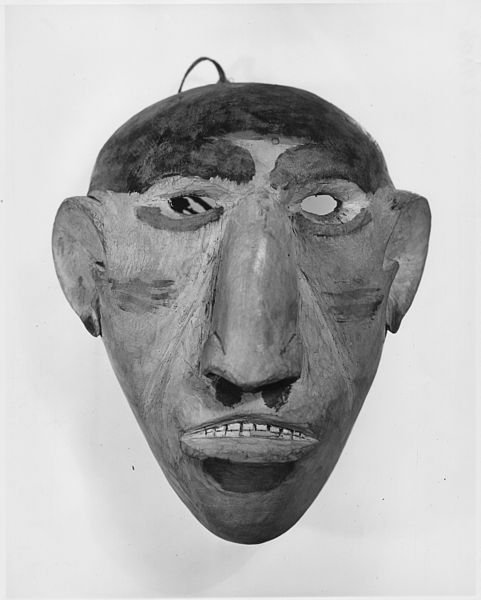 I toil, yes. Right now I'm busting down walls of action and scene selection as I move through the more tangible portion of the novel. The second draft for me is about pulling out concrete details. I don't get to the inner monologue of the narration until the start of my third draft, which I affectionately call "sweeps" because I'll repeatedly sweep over the text and wipe away unnecessary information while adding more details. The sweeps portion of my revision process is when the story begins to look like a real story.So I had already come to the determination that my main character, Dean's, main flaw was that he didn't trust people. I had concluded he only trusted his wife's opinion so when his coworkers came to him about concerns he didn't trust what they were saying. Now I don't hit readers over the head with this aspect of his character. Through Dean's repeated second guessing, the reader eventually realizes this flaw: lack of trust. I do this so readers will pick up his character flaw only moments before the climax of the novel. Then the reader understands his final actions a little better.
I toil, yes. Right now I'm busting down walls of action and scene selection as I move through the more tangible portion of the novel. The second draft for me is about pulling out concrete details. I don't get to the inner monologue of the narration until the start of my third draft, which I affectionately call "sweeps" because I'll repeatedly sweep over the text and wipe away unnecessary information while adding more details. The sweeps portion of my revision process is when the story begins to look like a real story.So I had already come to the determination that my main character, Dean's, main flaw was that he didn't trust people. I had concluded he only trusted his wife's opinion so when his coworkers came to him about concerns he didn't trust what they were saying. Now I don't hit readers over the head with this aspect of his character. Through Dean's repeated second guessing, the reader eventually realizes this flaw: lack of trust. I do this so readers will pick up his character flaw only moments before the climax of the novel. Then the reader understands his final actions a little better.
"Developing a character with genuine depth requires a focus on not just desire but how the character deals with frustration of her desires, as well as her vulnerabilities, her secrets, and especially her contradictions." -- By David Corbett
Then I'm thinking this through, getting ready to begin my "sweeps" stage of revision, and I realized not only does he not trust people but the way he deals with this mistrust is by being critical. So I'm thinking through the internalization of a third person point of view, which is how the novel is written, and I'm simultaneously reading Haruki Murakami's Kafka on the Shore (we all know Murakami is the king of internal monologue), and I'm asking myself, "So how should I gear Dean's internal monologue?" Then I asked myself, "How would he talk to his coworkers if he had no filter?" All of a sudden I heard Dean start to be judgmental. In fact, he was so harsh I could only conclude one thing: Dean's an asshole.
"Great fiction is fueled by bad decisions and human weakness." -- By Kristen Lamb
It's kinda scary because he's loosely based on myself. That must mean I'm an asshole. I'll have to mediate on that one and get back to you later. For now, Dean is the asshole (not me, well, maybe me), and he will be an unlikable character. So for some strange reason that gets me excited. I like the idea of writing an unlikable character. More evidence I might be an asshole. But the reason I'm excited to write an unlikeable character is for the challenge. I've not had a character who came to fruition as so distinct as unlikeable. This is an exciting new avenue for me.So I guess it'll be. I'm writing about an asshole, who may or may not be like myself, but either way I'm excited for the "sweeps."
Support a Native owned Etsy shop, Allies United, where I offer unique merch for allies of social justice movements, like MMIW, Native Lives Matter and Black Lives Matter. Take a look inside my Etsy shop here: etsy.com/shop/AlliesUnited.
(Image was borrowed from Wikimedia Commons)
#1 Writing Rule: Be Teachable
We writers area equal parts ego and vulnerable. The cliché is to develop a "tough skin" over the years and be able to take criticism. But we all think we're geniuses, and we are. Brilliant beasts who are magical at hiding our softest parts behind a shield of "I already know" and "You just don't understand the work."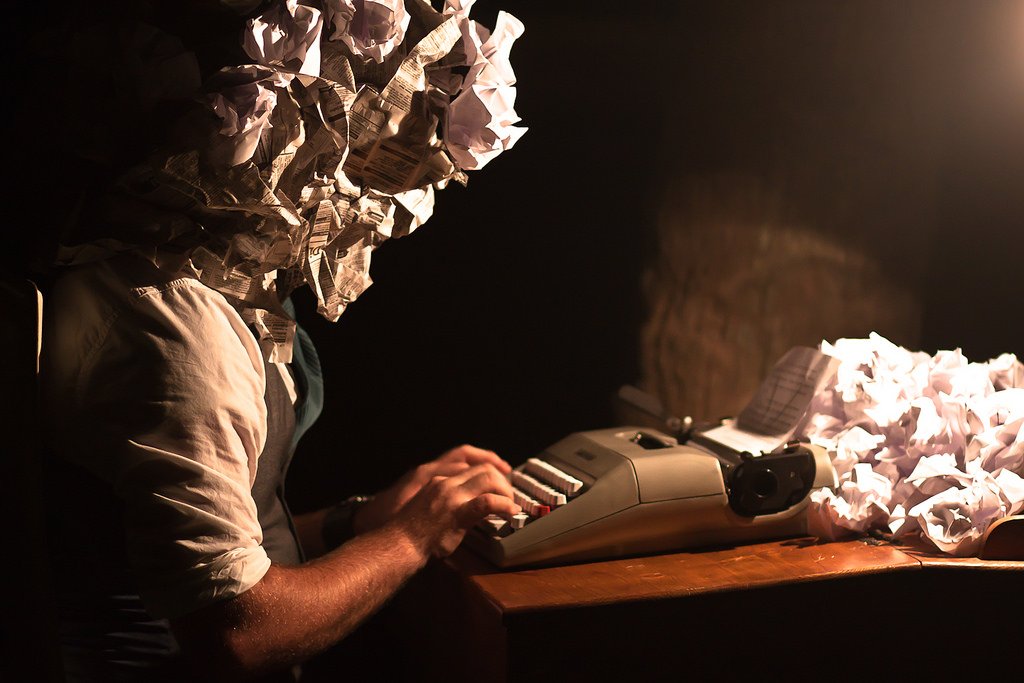 "Humble yourself, Oscar," often goes through my mind. One thing I've learned over the years of writing and revision and rejection and submission and rejection again and writing again and revision again is this: Be teachable.
"Humble yourself, Oscar," often goes through my mind. One thing I've learned over the years of writing and revision and rejection and submission and rejection again and writing again and revision again is this: Be teachable.
"The ultimate aim of the ego is not to see something, but to be something," By Muhammad Iqbal - Pakistani Poet
I say that and I also offer writers advice which will sound like a schism (and it is), but we need to retain our ego. We need to always remember we are undiscovered geniuses. We are the next brilliant thing to hit the writing world. We have the ability to transform this planet into something more habitable. And ultimately that's why we sit here everyday and write. To end oppression. To open up people's minds. To give readers a new way to look at life. Our genius is geared toward benevolence. Or at least that's what we tell ourselves, and I suggest we continue to do so.But at the same time we must be teachable. We must be able to take advice from other writers. It's the difference between wrestling against your ego and mastering it. When you are in control, you understand talent and skill must be executed with discipline.And the only way for a writer to obtain discipline is by listening to others.
Support a Native owned Etsy shop, Allies United, where I offer unique merch for allies of social justice movements, like MMIW, Native Lives Matter and Black Lives Matter. Take a look inside my Etsy shop here: etsy.com/shop/AlliesUnited.
(The above image was borrowed from Flickr)
Capricorn Mind on Structure and Writing Process
"I gotta keep my Capricorn mind straight," said the planet of Saturn to the writer writing this post. Okay, so that first sentence had a weird third person shift--almost like a third person shift to a different third person gear, but the first third person perspective was oddly different from the latter, which was equally bizarre but uniquely awkward. See what I mean? I do need to keep this Capricorn mind straight. Saturn was right. Everyone goes into their writing projects differently. No one does it the same so it can be hard to offer advice on how to start the process of writing on something as large as a novel. Many writers like writing blind. Meaning, they get the idea for the story and just start writing wherever the story begins in their mind and as they write the storyline will magically unfold. Well, not magically, but as you write then a sequence tends to come to mind so you follow the sequence. Then you revise and insert more elements to the story as they manifest along the way. That's writing in the dark.I do like writing in the dark for short stories. There seems to be an urgency to short stories that forces me to write it all down as fast as possible. People also call this the vomit method. I prefer to say writing in the dark. Regurgitation is not something I want to associate with my writing process. Or any of my process really.But for the novel? Maybe you've come up with a good idea. You've been wanting to write it for years, maybe decades, and you've not yet come to start the process. Writing a novel in the dark is possible. Many writers have done so and like the method. But I can't seem to do it.
Everyone goes into their writing projects differently. No one does it the same so it can be hard to offer advice on how to start the process of writing on something as large as a novel. Many writers like writing blind. Meaning, they get the idea for the story and just start writing wherever the story begins in their mind and as they write the storyline will magically unfold. Well, not magically, but as you write then a sequence tends to come to mind so you follow the sequence. Then you revise and insert more elements to the story as they manifest along the way. That's writing in the dark.I do like writing in the dark for short stories. There seems to be an urgency to short stories that forces me to write it all down as fast as possible. People also call this the vomit method. I prefer to say writing in the dark. Regurgitation is not something I want to associate with my writing process. Or any of my process really.But for the novel? Maybe you've come up with a good idea. You've been wanting to write it for years, maybe decades, and you've not yet come to start the process. Writing a novel in the dark is possible. Many writers have done so and like the method. But I can't seem to do it. Writing a novel has so many elements to it. Not only do you have the main plot, but you also have a series of subplots that can either mirror the main plot, highlight a trait of the main character, or be a complete escape from the main plot so as to break the tension or give the reader an opportunity to breath (while simultaneously showing a new side to the main character). All these subplots weave in and out of the main plot making for a beautifully constructed basket at the end.If you want to make beautiful art, a beautiful basket, you have to be purposeful with the way you weave each strand (subplot) against the basket's base (main plot). Because this process takes so much mental energy and careful planning, I like to outline my novels. Now I don't use an essay style outline. That would kill my energy quick. I can see you now. You're throwing your hands in the air and groaning, saying, "Oscar, I'm not going back to high school tactics to write a book." And I couldn't agree with you more.
Writing a novel has so many elements to it. Not only do you have the main plot, but you also have a series of subplots that can either mirror the main plot, highlight a trait of the main character, or be a complete escape from the main plot so as to break the tension or give the reader an opportunity to breath (while simultaneously showing a new side to the main character). All these subplots weave in and out of the main plot making for a beautifully constructed basket at the end.If you want to make beautiful art, a beautiful basket, you have to be purposeful with the way you weave each strand (subplot) against the basket's base (main plot). Because this process takes so much mental energy and careful planning, I like to outline my novels. Now I don't use an essay style outline. That would kill my energy quick. I can see you now. You're throwing your hands in the air and groaning, saying, "Oscar, I'm not going back to high school tactics to write a book." And I couldn't agree with you more. Here's what I do. I use One Note. If you haven't used it then I'd give it a try, or you can use something similar. What One Note gives me are tools I can use to creatively engage with my writing. Not only can I free write in random boxes, and then move those boxes around, but I can also draw out graphs. Hand made line graphs, not the standard graphs made for reports. I need something that makes sense to the flow of my story. I use the drawing tool and I'll draw zigzag lines leading up to the apex or crescendo of the story. Then I use text next to each peak and valley so as to mark what happens in the story. Typically, each peak and each valley represents a chapter.So when you go into outlining it doesn't have to be an English high school class all over again. You can get creative with it. But what I find? It helps me guide the story. I used this method with the novel I'm revising now, Uncle Called Him Spider, and I've started the outline of a new novel (which is why I'm writing this post). I'm about seven chapters deep into the outline of the new novel. I know the ending and I know the beginning, and I'm using the weaving method to create the middle. I actually enjoy this part of the process. It's the planning part, which comes from my Capricorn mind.
Here's what I do. I use One Note. If you haven't used it then I'd give it a try, or you can use something similar. What One Note gives me are tools I can use to creatively engage with my writing. Not only can I free write in random boxes, and then move those boxes around, but I can also draw out graphs. Hand made line graphs, not the standard graphs made for reports. I need something that makes sense to the flow of my story. I use the drawing tool and I'll draw zigzag lines leading up to the apex or crescendo of the story. Then I use text next to each peak and valley so as to mark what happens in the story. Typically, each peak and each valley represents a chapter.So when you go into outlining it doesn't have to be an English high school class all over again. You can get creative with it. But what I find? It helps me guide the story. I used this method with the novel I'm revising now, Uncle Called Him Spider, and I've started the outline of a new novel (which is why I'm writing this post). I'm about seven chapters deep into the outline of the new novel. I know the ending and I know the beginning, and I'm using the weaving method to create the middle. I actually enjoy this part of the process. It's the planning part, which comes from my Capricorn mind.
Support a Native owned Etsy shop, Allies United, where I offer unique merch for allies of social justice movements, like MMIW, Native Lives Matter and Black Lives Matter. Take a look inside my Etsy shop here: etsy.com/shop/AlliesUnited.
 (Images Cited: The images above were borrowed from Wikimedia Commons, Flicr, and Pinterest)
(Images Cited: The images above were borrowed from Wikimedia Commons, Flicr, and Pinterest)
Tiny Trophies Alongside the Road
Getting bogged down in the muck is an artist's nightmare. You've done the initial work. Maybe you painted the paintings, recorded the songs, or wrote the novels, and then you have to take the creation and offer it to world. Just when you thought you were done. There's a million more hurdles. When I wrote short stories I had these tiny trophies of publication to remind myself to keep going. I'd have the excitement of getting published and then the hardcopy would come in and then I'd be excited again. Then I'd get to tell family and friends. So each short story publication offered multiple rewards which would give me the fuel to keep myself in the grind.Don't get me wrong. I love to write. The space is a meditative space which is not matched by any substance on the planet. I can truly leave this planet when I sit down to write. The rest of the harsh world disappears. I'm left with my thoughts and my imagination; both aimed at solving the world's problems. It's powerful.But I would be lying if I didn't admit to days when I wished I was writing short stories again. I'm revising my novel, Uncle Called Him Spider, and writing a novel is a much longer journey. A marathon. It's been two years. Two years of running. It's been longer since I had a short story published. I'm feeling such a void maybe I'll pull out one of my old short stories; one I hadn't published, and I'll send it in to a journal. You would think we artists can survive with no attention at all, because for so long we survive without any light. But for those of us still seeking a space to call our own, some consistent stream of give and take with an audience, we must stay viable by any means. And sometimes those are tiny trophies alongside the road.
When I wrote short stories I had these tiny trophies of publication to remind myself to keep going. I'd have the excitement of getting published and then the hardcopy would come in and then I'd be excited again. Then I'd get to tell family and friends. So each short story publication offered multiple rewards which would give me the fuel to keep myself in the grind.Don't get me wrong. I love to write. The space is a meditative space which is not matched by any substance on the planet. I can truly leave this planet when I sit down to write. The rest of the harsh world disappears. I'm left with my thoughts and my imagination; both aimed at solving the world's problems. It's powerful.But I would be lying if I didn't admit to days when I wished I was writing short stories again. I'm revising my novel, Uncle Called Him Spider, and writing a novel is a much longer journey. A marathon. It's been two years. Two years of running. It's been longer since I had a short story published. I'm feeling such a void maybe I'll pull out one of my old short stories; one I hadn't published, and I'll send it in to a journal. You would think we artists can survive with no attention at all, because for so long we survive without any light. But for those of us still seeking a space to call our own, some consistent stream of give and take with an audience, we must stay viable by any means. And sometimes those are tiny trophies alongside the road.
Support a Native owned Etsy shop, Allies United, where I offer unique merch for allies of social justice movements, like MMIW, Native Lives Matter and Black Lives Matter. Take a look inside my Etsy shop here: etsy.com/shop/AlliesUnited.
(Works cited: the above image was borrowed from Wikimedia Commons)
Proximity's Unfortunate Consequence for Peripherals to the Writer's Gaze
There you are enjoying the advantages of not being accountable and then a writer moves in next door. At first you think, "Oh, this will be interesting...to have an artist type in the community," and then you realize writers write. More importantly, writers stand up for the weak, abused, and disadvantaged.Suddenly, you start to hear how divisive your words are, and you pause. You start a sentence and pause. Why? Because the writer just overheard you.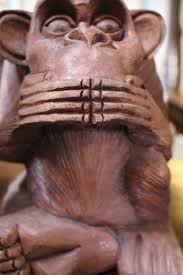 It's true. Friends of writers understand this aspect intimately, and have long accepted "Whatever they say will be held against them." But typically there are no deal breakers in their personality. By virtue of being around writers all the time they've come to exist in the world in a genuine and compassionate way. They know writers are intelligent and understand context and begin to trust us to not recount a situation outside of the space it was experienced.I write from personal experience. I write fiction. Not memoir or non-fiction. But what I've found is that to make fiction unique and your own, writing from personal experience is the best way to capture powerful and memorable moments.
It's true. Friends of writers understand this aspect intimately, and have long accepted "Whatever they say will be held against them." But typically there are no deal breakers in their personality. By virtue of being around writers all the time they've come to exist in the world in a genuine and compassionate way. They know writers are intelligent and understand context and begin to trust us to not recount a situation outside of the space it was experienced.I write from personal experience. I write fiction. Not memoir or non-fiction. But what I've found is that to make fiction unique and your own, writing from personal experience is the best way to capture powerful and memorable moments.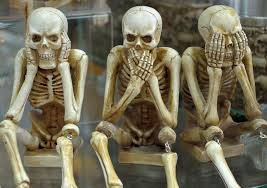 My first novel, which is in the revision phase right now, is about 90% true. In fact, it's so true all I had to do was change names and alter a few personalities. Scenes are arranged to maintain a story arch and to create dramatic action, but every scene is based on truth, based on a real experience. Sometimes you live through a series of events and, as a writer, you can't believe your unfortunate and fortunate luck. It is so terrible and magnificent, simultaneously, that you say to yourself, "This is playing out like a novel." Then a year after you've left the situation, you have distance enough to write about it. That's what happened to me. It was a hard situation to live through, but worth every word on the page.So if you find yourself in proximity to a writer, don't be surprised if you end up fictionalized among the pages. And if you don't want to be a villain in fiction, then don't be one in real life.
My first novel, which is in the revision phase right now, is about 90% true. In fact, it's so true all I had to do was change names and alter a few personalities. Scenes are arranged to maintain a story arch and to create dramatic action, but every scene is based on truth, based on a real experience. Sometimes you live through a series of events and, as a writer, you can't believe your unfortunate and fortunate luck. It is so terrible and magnificent, simultaneously, that you say to yourself, "This is playing out like a novel." Then a year after you've left the situation, you have distance enough to write about it. That's what happened to me. It was a hard situation to live through, but worth every word on the page.So if you find yourself in proximity to a writer, don't be surprised if you end up fictionalized among the pages. And if you don't want to be a villain in fiction, then don't be one in real life.
Support a Native owned Etsy shop, Allies United, where I offer unique merch for allies of social justice movements, like MMIW, Native Lives Matter and Black Lives Matter. Take a look inside my Etsy shop here: etsy.com/shop/AlliesUnited.
(Works Cited: Images were borrowed from PxHere and Pixabay)
Drama Triangle: Enhancing Victimhood with Vengeance and Sacrifice
I don't denounce structuralism. Every time I watch a Disney or Pixar movie with my daughters and tears start welling up in my eyes by simple structural tactics, like music and camera angles, I'm reminded there is a reason it works. But I'm a literary writer and we are defiant bastards and we like to take structuralism and bend it our will. So we can look in the mirror and say to ourselves, "The industry will not make me a slave."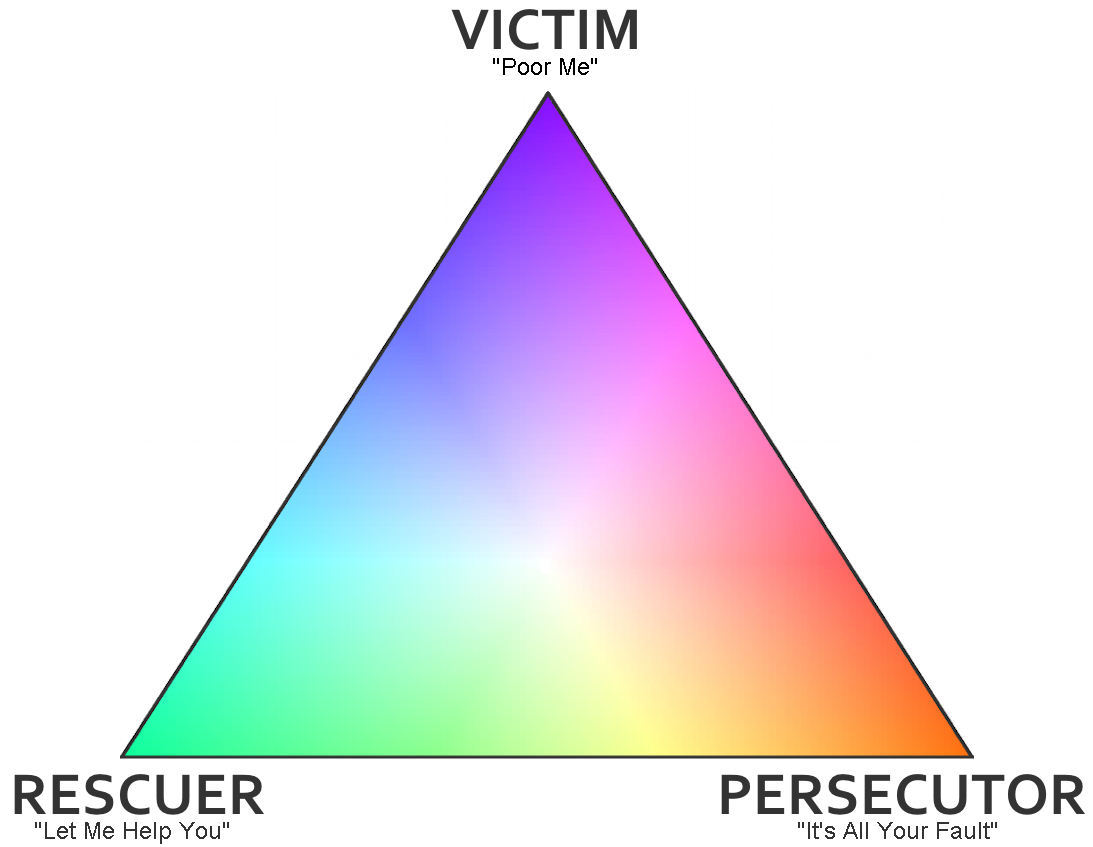 The above diagram is one of the tools I use to write fiction. I learned this from an adjunct professor at the Institute of American Indian Arts, where I obtained my BFA in Creative Writing. It has helped tremendously. I use it over and over and weigh each character against it.So to create a dynamic character in your story, you have to apply all three to your main characters, including the antagonist. This will have your character looking three dimensional, like a real human being. Easy enough.But I'm a nerd and a writerly nerd at that so I think about writing often and techniques and how they're applicable to what I'm working on. Right now, I'm revising my first novel so I spend a lot of time thinking about the above diagram.Mostly, of recent, I've been thinking of the victim dimension, and it, like the other two, can appear to be straight forward. Then I start to ask: What kind of victim? How many victim types can there be? Then I start to make an interesting list. There is the wallow in self pity victim. There is the weaponize my victimhood victim. There is the vengeful victim. And then there is the savior victim.What I've come to find is a character is more dynamic and interesting and resonates when the character can exhibit as many traits of the victim as possible. Why? For the same reason you want your main character to have all three dimensions in the diagram above, because it makes them appear more complex, more real, more human.What is more interesting to me is that when you mix victim with the rescuer you get the savior victim (those who have been violated and have returned to rescue you from your own brutality), and when you mix victim with the persecutor you get the vengeful victim (those who have been violated and have returned to make you pay). The main character in my novel, Dean, plays victim/rescuer to certain individuals in the novel, but toward the antagonist he plays victim/persecutor.But what makes me most excited about my novel is when Dean exacts vengeance on the antagonist he is doing it in the name of all the victims the antagonist has metaphorically killed in the novel, so subsequently he blends rescuer and persecutor. More or less, he throws himself on a grenade.What are your thoughts? How might you blend the three different roles listed above? Have you applied the drama triangle to your writing? What was the outcome?(Works Cited: The above image was borrowed from Wikimedia commons.)
The above diagram is one of the tools I use to write fiction. I learned this from an adjunct professor at the Institute of American Indian Arts, where I obtained my BFA in Creative Writing. It has helped tremendously. I use it over and over and weigh each character against it.So to create a dynamic character in your story, you have to apply all three to your main characters, including the antagonist. This will have your character looking three dimensional, like a real human being. Easy enough.But I'm a nerd and a writerly nerd at that so I think about writing often and techniques and how they're applicable to what I'm working on. Right now, I'm revising my first novel so I spend a lot of time thinking about the above diagram.Mostly, of recent, I've been thinking of the victim dimension, and it, like the other two, can appear to be straight forward. Then I start to ask: What kind of victim? How many victim types can there be? Then I start to make an interesting list. There is the wallow in self pity victim. There is the weaponize my victimhood victim. There is the vengeful victim. And then there is the savior victim.What I've come to find is a character is more dynamic and interesting and resonates when the character can exhibit as many traits of the victim as possible. Why? For the same reason you want your main character to have all three dimensions in the diagram above, because it makes them appear more complex, more real, more human.What is more interesting to me is that when you mix victim with the rescuer you get the savior victim (those who have been violated and have returned to rescue you from your own brutality), and when you mix victim with the persecutor you get the vengeful victim (those who have been violated and have returned to make you pay). The main character in my novel, Dean, plays victim/rescuer to certain individuals in the novel, but toward the antagonist he plays victim/persecutor.But what makes me most excited about my novel is when Dean exacts vengeance on the antagonist he is doing it in the name of all the victims the antagonist has metaphorically killed in the novel, so subsequently he blends rescuer and persecutor. More or less, he throws himself on a grenade.What are your thoughts? How might you blend the three different roles listed above? Have you applied the drama triangle to your writing? What was the outcome?(Works Cited: The above image was borrowed from Wikimedia commons.)
Voice Echoes in Mimetic Hearing
How to hear? Not to listen, like saying "You need to pay attention," but instead how we create consistency in our voice as artists. How do we hear voice? How do we recognize what is uniquely our own? Is one obstacle. Then the next. How do we reproduce it again and again?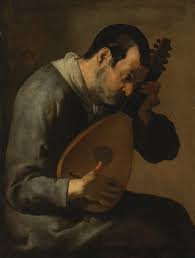 It might seem easy on the surface. Once you do something, just do that same thing again. Then again. Then again. And on and on. But tell that to an artist. If you've ever shot a three pointer on the basketball court, you know it's muscle memory that allows the odds of hitting those threes over and over. When you're first starting to understand voice in your art you have moments when you hit nothing but net. Then you have moments when you air ball shot after shot, and you start to question, "How did I make those shots before?"As a creative writer, I've written stories with a certain voice and this voice was born out of my Kiowa community, which is interlaced with the Comanche community (many of my relatives are half Comanche). In my short story, Our Dance, the narrator is from Lawton, Oklahoma and he recounts when he received a per capita check from the Kiowa tribe. The story reflects my and other family member's experiences when we received money at the age of 18. The story wrote itself. The voice came so quickly and naturally it was an out of body experience to write it. Some spirit from within took me over and used me to write the story--was how it felt.Then I wrote other stories trying to capture similarly the Cherokee voices in my Cherokee community of Tahlequah, Oklahoma. My reason? I wanted to show people the beauty in our differences. How unique each tribe is. Often we Native Americans are lumped into the same group, and we do share a common experience and this history undoubtedly binds us together for many generations to come, and at the same time people from the outside often adhere to ubiquity and miss our essence as individual tribes. This is a great modality for a writer, but it spelled doom for my ability to capture a singularly unique voice as an artist.What was the consequence?I went into a tailspin for several years. Mimesis often locks me in circles that produce interesting pieces of literature, but it can also bind me into a cycle (or obsession) with topics that are distracting, like battling ubiquity.
It might seem easy on the surface. Once you do something, just do that same thing again. Then again. Then again. And on and on. But tell that to an artist. If you've ever shot a three pointer on the basketball court, you know it's muscle memory that allows the odds of hitting those threes over and over. When you're first starting to understand voice in your art you have moments when you hit nothing but net. Then you have moments when you air ball shot after shot, and you start to question, "How did I make those shots before?"As a creative writer, I've written stories with a certain voice and this voice was born out of my Kiowa community, which is interlaced with the Comanche community (many of my relatives are half Comanche). In my short story, Our Dance, the narrator is from Lawton, Oklahoma and he recounts when he received a per capita check from the Kiowa tribe. The story reflects my and other family member's experiences when we received money at the age of 18. The story wrote itself. The voice came so quickly and naturally it was an out of body experience to write it. Some spirit from within took me over and used me to write the story--was how it felt.Then I wrote other stories trying to capture similarly the Cherokee voices in my Cherokee community of Tahlequah, Oklahoma. My reason? I wanted to show people the beauty in our differences. How unique each tribe is. Often we Native Americans are lumped into the same group, and we do share a common experience and this history undoubtedly binds us together for many generations to come, and at the same time people from the outside often adhere to ubiquity and miss our essence as individual tribes. This is a great modality for a writer, but it spelled doom for my ability to capture a singularly unique voice as an artist.What was the consequence?I went into a tailspin for several years. Mimesis often locks me in circles that produce interesting pieces of literature, but it can also bind me into a cycle (or obsession) with topics that are distracting, like battling ubiquity. Ultimately, I learned I can address this issue of homogeneity in other ways. I've come full circle recently and am starting to look toward the voice that came out of my Kiowa community as the voice I'm going to use in my literature. I'm revising my first novel and yesterday I came to chapter 13 and somehow my Kiowa "voice" started to manifest. I suddenly could "hear" the tone and pitch of my community laced in the words. The voice is a little different than when I wrote Our Dance, but I'm excited to see how it has grown. My advice for other writers: hear your community, hear your family, pause and hear. Don't listen, because you'll only focus on the words. Hear the vowels rise or drop. Hear the absence of consonants. Hear the subtle pauses.Then when you hear the voice you're going to use in your art: capture it quickly. Produce something you can return to time and again. Every time you reread that story, you look at that painting, or you sing that song take it and transfer it into the next project and then the next. Always go back to the original voice in the same way you always go back home. Even if it's just to remember where you came from.
Ultimately, I learned I can address this issue of homogeneity in other ways. I've come full circle recently and am starting to look toward the voice that came out of my Kiowa community as the voice I'm going to use in my literature. I'm revising my first novel and yesterday I came to chapter 13 and somehow my Kiowa "voice" started to manifest. I suddenly could "hear" the tone and pitch of my community laced in the words. The voice is a little different than when I wrote Our Dance, but I'm excited to see how it has grown. My advice for other writers: hear your community, hear your family, pause and hear. Don't listen, because you'll only focus on the words. Hear the vowels rise or drop. Hear the absence of consonants. Hear the subtle pauses.Then when you hear the voice you're going to use in your art: capture it quickly. Produce something you can return to time and again. Every time you reread that story, you look at that painting, or you sing that song take it and transfer it into the next project and then the next. Always go back to the original voice in the same way you always go back home. Even if it's just to remember where you came from.
Support a Native owned Etsy shop, Allies United, where I offer unique merch for allies of social justice movements, like MMIW, Native Lives Matter and Black Lives Matter. Take a look inside my Etsy shop here: etsy.com/shop/AlliesUnited.
(Cited: Images were borrowed from Wikipedia and Wikimedia Common).
Impetus for Creative Spawn
Like angels and devils breading hordes of bastard monstrosities, the impetus for the type of stories I like to write comes out of the comingling of two polar opposite ideologies. One is quite happy frolicking with idealism and innocence, while the other takes great pleasure in torturing countless victims. Together they make for unpleasant friends. The type to cater to your highest morals and simultaneously use those morals to bash you into the dirt.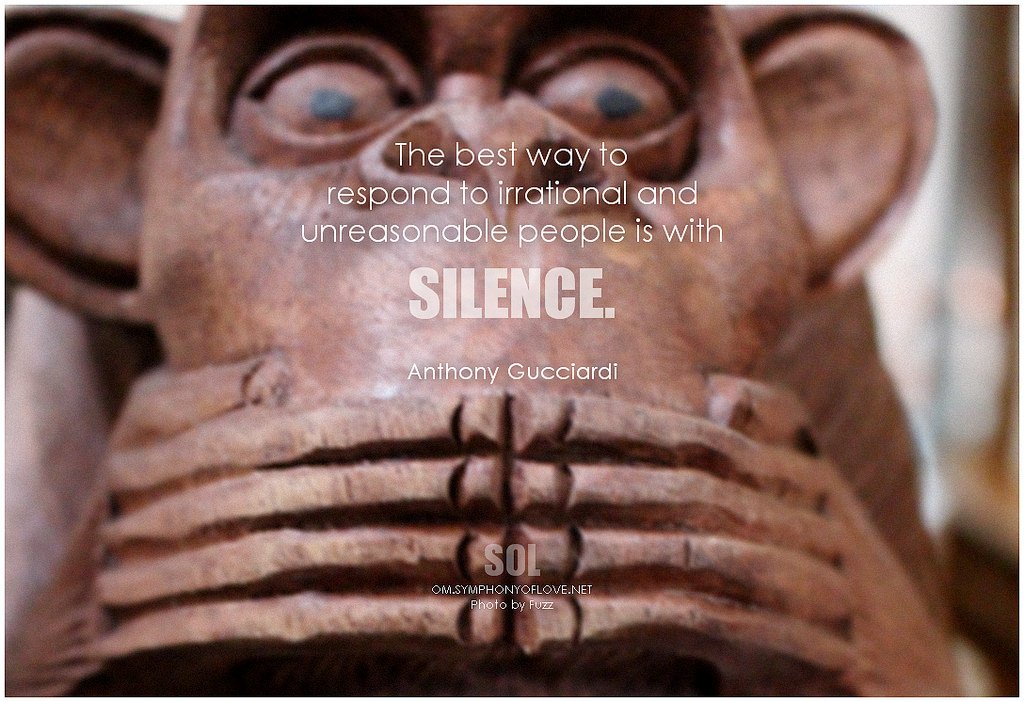 More or less, I can't write a story (or complete a story I should say) unless I'm telling on someone. I've thought about this extensively. Largely because I was stuck for a long time, years even, on getting a collection of short stories to completion. Now I'm writing a novel and burning through the second revision phase. I think a lot about writerly things, like why I write, what drives me, why did I get stuck, and how did I get unstuck? When you're deep in the muck that is stagnation you will contemplate ideas and processes you never would in other circumstances.One of the conclusions I realized recently was that I could not and still can not complete, finish, finalize, bring to fruition, totalize a story unless I am telling on someone. I always write from real life experiences. I fictionalize small things here and there to create a strong story arch, but more or less everything I've written has been about something that has truly happened to me, or to someone around me.In the previously mentioned short story collection, Reflections on the Water, I had a number of stories that were fantastic conceptually. They would have made for great stories, and maybe they will one day when I go back to them. But what I discovered was that the stories didn't keep me interested because I wasn't trying to get someone in trouble. Meaning, the characters weren't divulging something terrible in each other.I tend to like the big issues and the most disgusting behavior, like racism, sexism, homophobia, and all the oppressive qualities that they tend to come with. Typcially, there also has to be systemic issues that reflect the micro behavior, so if a character says something racist against Native people (or dark skinned Native people) we get that people live isolated lives and keep their circles very small because they aren't emotionally strong enough to expand their circle. They're emotionally like a child and need any and every form of protection to make them feel all snuggly safe.What makes the issue more interesting, or interesting enough for me to complete a short story or add into a novel, is if the racism is supported by an entire system. Not necessarily an entire community, but it could be that. I like things that show systemic issues on a smaller scale than community or national. It makes the issue more tangible and readers, including myself, can actually witness the details of such gross behavior. So if there is an organization that is supporting oppression of Native voices (or dark skinned Native voices), then it becomes more tangible, because readers will immediately reflect on their own place of work and determine if they run into the same issue. They'll either recognize it and see how the issue is real and needs to be changed. Or they will not recognize it and say to themselves "What's wrong with the people in this book/community?" Either type of judgment works for me. I'm looking for a reaction that will drive people to action.I've started great stories that made it through several drafts and one in particular that made it all the way to what I thought was a final draft, but they turned out to lose steam. Why? Because of the absence of micro and macro societal abuse. If one or the other is singularly present in the story it will fail. If it has both? Micro and macro? The statement along with the condoning voices in the room. That's what makes for a good story. A story readers will want to read over and over again.
More or less, I can't write a story (or complete a story I should say) unless I'm telling on someone. I've thought about this extensively. Largely because I was stuck for a long time, years even, on getting a collection of short stories to completion. Now I'm writing a novel and burning through the second revision phase. I think a lot about writerly things, like why I write, what drives me, why did I get stuck, and how did I get unstuck? When you're deep in the muck that is stagnation you will contemplate ideas and processes you never would in other circumstances.One of the conclusions I realized recently was that I could not and still can not complete, finish, finalize, bring to fruition, totalize a story unless I am telling on someone. I always write from real life experiences. I fictionalize small things here and there to create a strong story arch, but more or less everything I've written has been about something that has truly happened to me, or to someone around me.In the previously mentioned short story collection, Reflections on the Water, I had a number of stories that were fantastic conceptually. They would have made for great stories, and maybe they will one day when I go back to them. But what I discovered was that the stories didn't keep me interested because I wasn't trying to get someone in trouble. Meaning, the characters weren't divulging something terrible in each other.I tend to like the big issues and the most disgusting behavior, like racism, sexism, homophobia, and all the oppressive qualities that they tend to come with. Typcially, there also has to be systemic issues that reflect the micro behavior, so if a character says something racist against Native people (or dark skinned Native people) we get that people live isolated lives and keep their circles very small because they aren't emotionally strong enough to expand their circle. They're emotionally like a child and need any and every form of protection to make them feel all snuggly safe.What makes the issue more interesting, or interesting enough for me to complete a short story or add into a novel, is if the racism is supported by an entire system. Not necessarily an entire community, but it could be that. I like things that show systemic issues on a smaller scale than community or national. It makes the issue more tangible and readers, including myself, can actually witness the details of such gross behavior. So if there is an organization that is supporting oppression of Native voices (or dark skinned Native voices), then it becomes more tangible, because readers will immediately reflect on their own place of work and determine if they run into the same issue. They'll either recognize it and see how the issue is real and needs to be changed. Or they will not recognize it and say to themselves "What's wrong with the people in this book/community?" Either type of judgment works for me. I'm looking for a reaction that will drive people to action.I've started great stories that made it through several drafts and one in particular that made it all the way to what I thought was a final draft, but they turned out to lose steam. Why? Because of the absence of micro and macro societal abuse. If one or the other is singularly present in the story it will fail. If it has both? Micro and macro? The statement along with the condoning voices in the room. That's what makes for a good story. A story readers will want to read over and over again.
Support a Native owned Etsy shop, Allies United, where I offer unique merch for allies of social justice movements, like MMIW, Native Lives Matter and Black Lives Matter. Take a look inside my Etsy shop here: etsy.com/shop/AlliesUnited.
(Works Cited: The image above was borrowed from flicr.)
When Reincarnated Narratives are Lost to Unpredictable Rollercoasters
"How many lives do you think you have lived?" someone asked me, and I responded "In this lifetime, I'm on seven." I'm sure she meant previous lives, as in reincarnation in its literal meaning, but if you're going to have a conversation with an artist you have to understand our minds work in symbols. I'm going to speak metaphorically before I speak literally. It makes more sense to do so when you consider the multifarious dynamics in life. Everything is fluid, ever changing, like narratives and lifetimes and phases, making for a rollercoaster ride in the dark. Today I'm reflecting on how my writing process correlates to where I'm at in life. There are two time periods I'm thinking of specifically. The now, and the just before now. My most recent life was a life of being "stuck" and it took drastic measures to become unstuck. Now I'm in the life of freedom, where I can freely write and be creative (ultimately be myself) without any interference.I was working on a collection or short stories in the previous life and I've since abandoned these short stories. I wasn't sure why. I'm still not completely certain but I have a better understanding about my process during that time period and how it reeked of stagnation. I abandoned the collection of short stories because psychologically I felt my spirit drain as soon as I would go into revising the stories. Some of the stories where completed and published, like Our Dance and Time like Masks, and others were almost to completion while some still needed heavy revisions.
Today I'm reflecting on how my writing process correlates to where I'm at in life. There are two time periods I'm thinking of specifically. The now, and the just before now. My most recent life was a life of being "stuck" and it took drastic measures to become unstuck. Now I'm in the life of freedom, where I can freely write and be creative (ultimately be myself) without any interference.I was working on a collection or short stories in the previous life and I've since abandoned these short stories. I wasn't sure why. I'm still not completely certain but I have a better understanding about my process during that time period and how it reeked of stagnation. I abandoned the collection of short stories because psychologically I felt my spirit drain as soon as I would go into revising the stories. Some of the stories where completed and published, like Our Dance and Time like Masks, and others were almost to completion while some still needed heavy revisions. This collection of short stories was titled Reflections on the Water. And I had to push myself to gather these stories together. It was tremendous spiritual labor to do so. There was something that kept pulling me back. I didn't have the same energy to revise the stories. Our Dance and Time like Masks were written with a different energy but I had written those stories in the lifetime before my last life (in the fifth life) so I had a different energy. In the sixth life, there was something vampiric keeping me from being fully submersed in my writing. I hated it.Needless to say Reflections on the Water didn't go anywhere. The collection sits on one of my flash drives in limbo. I don't know what I'm going to do with the stories. Maybe they will be reincarnated into this life (following me on my writing journey), but for now I've left them behind. I'm not with them anymore. I'm somewhere else in a different lifetime. But I think of these stories from time to time, like thinking of an old friend from childhood.I had even tried to gather energy for the collection through an online funding platform, Indiegogo. But I think ultimately I was trying desperately to make myself finish this collection. I was forcing the creativity or trying to do so. And if you're an artist you know there is no making creativity do what you want it to do. It comes on days when you least expect and doesn't when you wished it would. I think I had to relearn to allow creativity to take me over, to allow it inside, as opposed to forcing it. You may beckon the muse differently, but mine is temperamental with a short fuse and I have to placate her with modesty and humility.These days I sit with my writing and wait. I humble myself to its power. I come with more patience than I had before, maybe because I'm older or maybe because I've been burned by the beast and now know better. I've been reincarnated and my writing process has as well. I come at my stories differently than I had a few years ago. The ride in the dark has been a rollercoaster and it's exciting to know I'm on a new path and I'm excited to think of the lives to come.
This collection of short stories was titled Reflections on the Water. And I had to push myself to gather these stories together. It was tremendous spiritual labor to do so. There was something that kept pulling me back. I didn't have the same energy to revise the stories. Our Dance and Time like Masks were written with a different energy but I had written those stories in the lifetime before my last life (in the fifth life) so I had a different energy. In the sixth life, there was something vampiric keeping me from being fully submersed in my writing. I hated it.Needless to say Reflections on the Water didn't go anywhere. The collection sits on one of my flash drives in limbo. I don't know what I'm going to do with the stories. Maybe they will be reincarnated into this life (following me on my writing journey), but for now I've left them behind. I'm not with them anymore. I'm somewhere else in a different lifetime. But I think of these stories from time to time, like thinking of an old friend from childhood.I had even tried to gather energy for the collection through an online funding platform, Indiegogo. But I think ultimately I was trying desperately to make myself finish this collection. I was forcing the creativity or trying to do so. And if you're an artist you know there is no making creativity do what you want it to do. It comes on days when you least expect and doesn't when you wished it would. I think I had to relearn to allow creativity to take me over, to allow it inside, as opposed to forcing it. You may beckon the muse differently, but mine is temperamental with a short fuse and I have to placate her with modesty and humility.These days I sit with my writing and wait. I humble myself to its power. I come with more patience than I had before, maybe because I'm older or maybe because I've been burned by the beast and now know better. I've been reincarnated and my writing process has as well. I come at my stories differently than I had a few years ago. The ride in the dark has been a rollercoaster and it's exciting to know I'm on a new path and I'm excited to think of the lives to come.
Support a Native owned Etsy shop, Allies United, where I offer unique merch for allies of social justice movements, like MMIW, Native Lives Matter and Black Lives Matter. Take a look inside my Etsy shop here: etsy.com/shop/AlliesUnited.
(Works Cited: The images were borrowed from PxHere and Wikimedia.)


